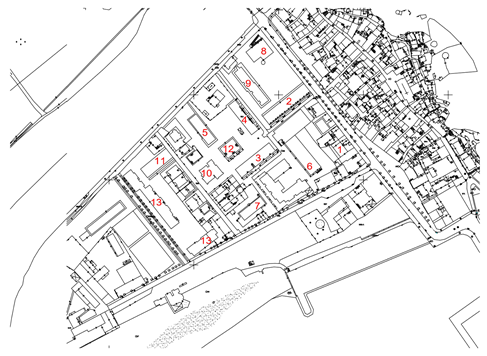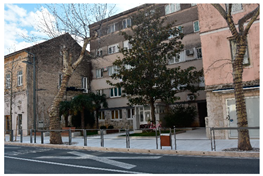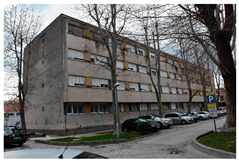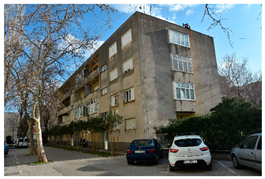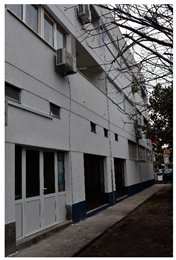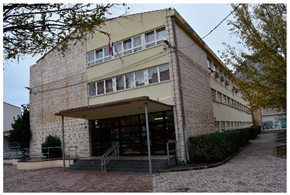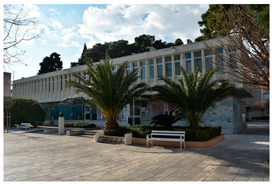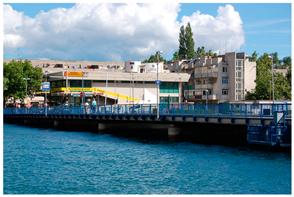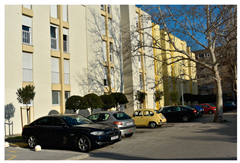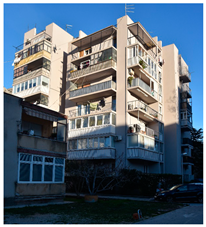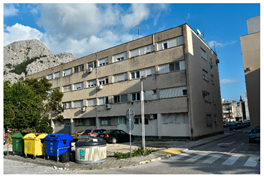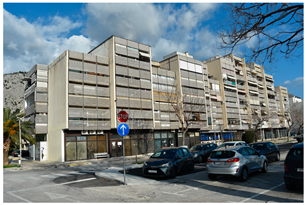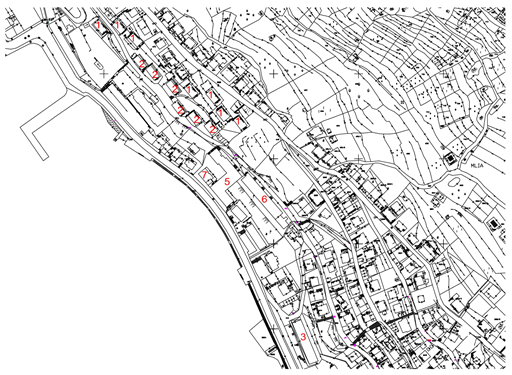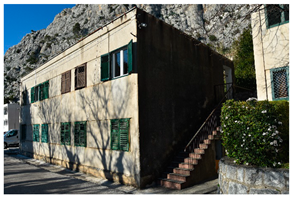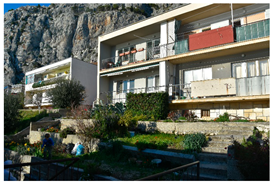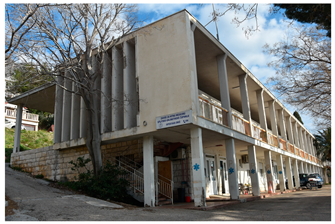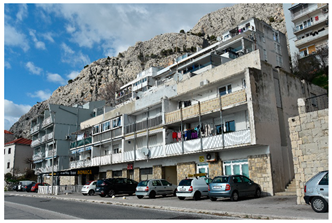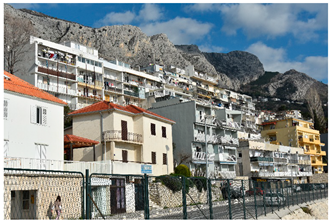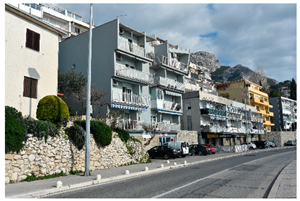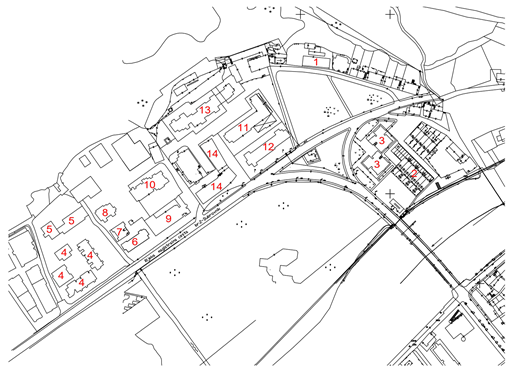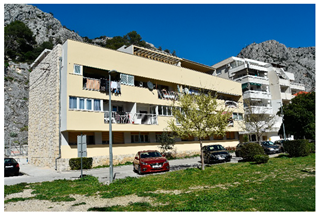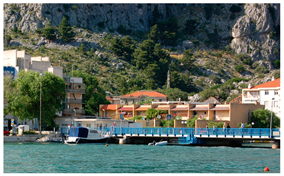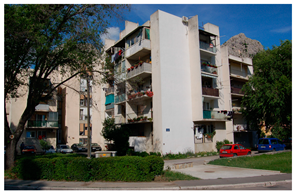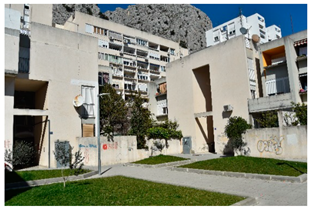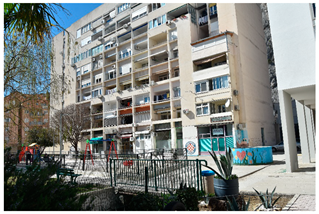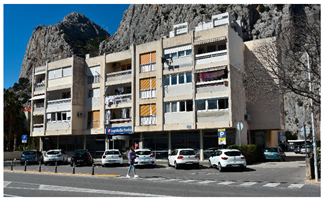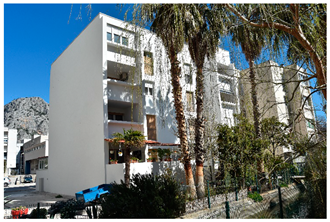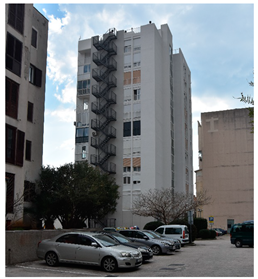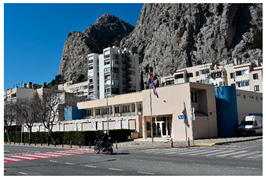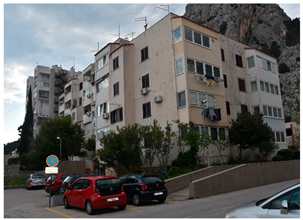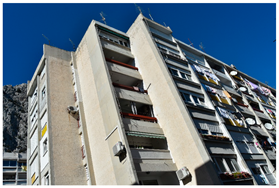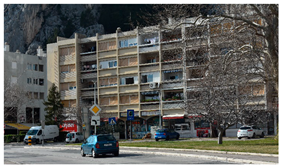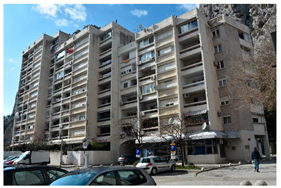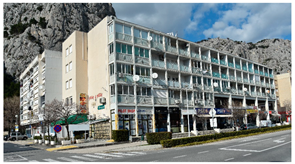Abstract
Omiš is characterised by an exceptional layering of its natural environment and historical architecture, which is why its modern achievements have not been fully researched so far. The aim of this scientific paper is a more comprehensive study of the modern architecture of Omiš of the second half of the 20th century. Its architectural corpus has remained in the shadow of modern architectural realisations of the nearby city of Split, which belongs to the same prominent protagonists of modernity. Work methods in this paper have included the analysis of primary and secondary sources and research of the current situation in the field. This work, for the first time, gives a systematic presentation of the modern architecture of this picturesque town while the elements of the author’s expression integrate features of modern architecture and reinterpret the tradition of life in the Mediterranean.
1. Introduction
The Mediterranean Sea is surrounded by the shores of three continents, Europe, Asia, and Africa. Ancient civilisations, from the Egyptian, to the Aegean-Cretan, to the European, all developed along its coast in antiquity. The Mediterranean climate is characterised by hot summers and mild winters. The abundance of sunlight creates strong contrasts of light and shadow and, in a specific way, affects the architecture of the region as well as the atmosphere of life.
Le Corbusier himself sought inspiration for his creativity in his youthful study trips to the Orient and the Mediterranean. His rich sketchbooks testify to the mix of inspiration, knowledge, and wisdom he absorbed. All of them together represent the sources of inspiration for his work and an exceptional contribution to the development of the modern architecture of the 20th century. Ultimately, Le Corbusier spent his last years on the shores of the Mediterranean, absorbing its inspirational energy.
Croatia borders the eastern coast of the Adriatic Sea, which is extremely indented and has over a thousand islands and islets. The wealth of natural beauty and historical sights is reflected in the inscription of these on the list of UNESCO’s cultural and natural heritage. Ten immovable cultural properties on the territory of the Republic of Croatia have been inscribed onto the UNESCO World Heritage List, and 18 cultural properties have been inscribed onto the UNESCO Representative List of the Intangible Cultural Heritage of Humanity [1].
Having such a layered heritage, modern architecture escapes the focus of protection at the national level. Although modern architecture is systematically researched at the university, scientific, and professional levels, a number of significant achievements fail to be noticed by the profession, and especially the wider public.
Croatian modern architecture represents a focus of many professional and scientific studies within Croatia, and to a degree internationally. Since the second half of 20th century, it has been continuously presented and published in professional and scientific journals (Čovjek i prostor, Arhitektura, Prostor, Oris, etc.) [2,3,4], books, internet sites, scientific projects, etc. It has recently been internationally recognized: for example, at Venice Biennale, curated by Professor Karin Šerman in 2014, focusing upon 100 years of Croatian architecture within the exhibition curated by Rem Koolhaas, and the exhibition “Toward a Concrete Utopia: Architecture in Yugoslavia 1948–1980,” organised by Martino Stierli, held at the Museum of Modern Art (MoMA) in New York (2018–2019) [5,6]. This paper focuses on the, so far not sufficiently focused upon or integrally researched, architectural Modernism of Omiš, a city situated on the east coast of the Adriatic Sea, some twenty kilometres from Split, a major centre of the area. The small City of Omiš and its modernist layer has so far been omitted as a site of complete research. An exceptional topography of the terrain, coupled with a natural beauty, characterises this part of Dalmatia (Figure 1).
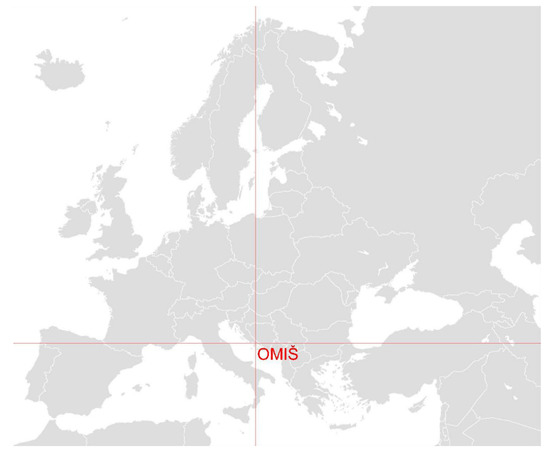
Figure 1.
Location of Omiš (Based on: https://upload.wikimedia.org/wikipedia/commons/0/0c/Blank_map_Europe_with_borders.png; San Jose, public domain, via Wikimedia Commons, accessed on 29 January 2023).
The southern area is defined by the Brač Channel and the eponymous island across the sea, whereas the hinterland pertains to Poljica, a diminutive derived from the word polje, meaning field. The coastal mountain range is cut through by the River Cetina on its way to the sea, creating a canyon separating the Mount of Poljica from Mount Dinara (Figure 2).
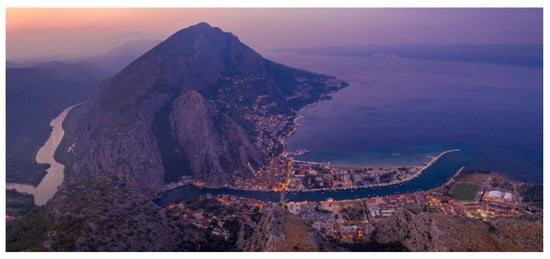
Figure 2.
Aerial photo of the town of Omiš, the canyon and mouth of the river Cetina, and the mountain range in the hinterland. View from the west (source: Omiš Tourist Board, Omiš, 1A Fošal, 2023).
2. Historical Development of Omiš
The Medieval City of Omiš was built east of the mouth of the River Cetina, at the bottom of steep cliffs of limestone mountains. The fortification system of city walls with towers was built in the northwest, southeast, and southwest between the 13th and 16th centuries, for the purpose of defence against the Venetian Republic and the Ottoman Empire. Over the course of history, Omiš had a major strategic importance. Its citizens controlled the navigation in the East Adriatic, thereby ensuring the very existence and the autonomy of the municipality. The south Medieval gateway connected the city with the Peninsula of Punta, featuring fecund soil deposited by the river where the population cultivated their fields. In the 13th century, the fortification tower of Peovica (Mirabella) was erected, offering an excellent view of the city and its immediate surroundings. At a greater height above sea level, another fortress, called Starigrad, was built, from which navigation in the Brač Channel could be observed and controlled, something extremely important to the citizens, who were legendary seamen (and pirates) [7,8,9].
In the 20th century, the city of Omiš started spreading southwestwards onto the wedge-shaped Peninsula of Punta, and the filled-up defence trench, today’s Fošal Street, represents a clear dividing line between the historical and the modern city. Fošal Street was integrated into the Adriatic Highway, passing through the City of Omiš. This busy thoroughfare, extending along the entire Eastern Adriatic Coast in the immediate vicinity of the seashore, was built in the second half of the 20th century. The Adriatic Highway has brought life, industry, and tourism to these, until then, isolated Adriatic areas. However, it has also caused devastation of the landscape along its entire route.
In the years after the Second World War, devastated residential buildings and hotels in Omiš and other Croatian cities were rebuilt. Electrification of the villages was carried out, a water supply network was established, and a system of roads was constructed. Most of these roads were macadam except for the Adriatic Highway, the only modern, asphalted road. Pre-war industrial facilities (carbide and cyanamide factory “Dalmacija” in Dugi Rat, textile factory “Galeb” in Omiš, cement factory “Renko Šperac” in Ravnice) were modernized, while some industrial facilities were closed due to their outdated technology and non-competitiveness on the market (food factory “First Mosor Detachment” from Omiš). Before the Second World War, Omiš and the neighboring towns on the coast (Mali Rat and Krilo Jesenice) were involved in tourism, receiving guests in several hotels, guesthouses, and private accommodations. During the war, these tourist facilities were used to house the army. Some were converted into residential buildings in the years after the war, and a few were renovated and returned to their original purpose. In the 1960s, camps were opened, Ribnjak in Omiš and Ruskamen in Lokva Rogoznica east of Omiš, as well as several resorts for trade union summer vacations for workers employed in companies and institutions from all over the country. In those years, the construction of a hotel designated for foreign tourists began in Omiš. Other coastal towns were designated for the development of domestic tourism [10].
Omiš’s economy was traditionally oriented towards industry but, from the mid-1960s, it also turned to tourism. In the hinterland of Omiš, the population was mainly engaged in agriculture. In the mid-1950s and -1960s, a large number of villagers moved to the centers of industrial production, Omiš and nearby Dugi Rat, for employment. The richness of the water potential of the Cetina River predestined this region for the production of electricity from the beginning of the 20th century. This gave the Cetina region national importance in that sector of the economy. The Kraljevac hydroelectric power plant was finished before the First World War. In the late 1950s and early 1960s, two hydropower plants were built, the Peruča hydropower plant and the Zakučac hydropower plant in the hinterland of Omiš. The last hydroelectric power plant, in Đale, was built at the end of the 1980s. Approximately 2000 people worked on the construction of the Zakučac hydroelectric power plant. Aware that such a large number of workers working on the construction of the plant would be out of a job upon completion, the government at the time advocated for the development of agriculture [11]. In the post-war period, a positive trend was felt in the economic and social development of the city of Omiš. It became the center of the southern area of the Cetina region (the lower Cetina basin), which gravitates towards it [12,13,14,15].
The development of industry started the process of the urbanization of Omiš and intensive housing construction was undertaken under the supervision of the municipal authorities. In 1959, these issued two important documents that designers of residential buildings in the area of Omiš Municipality had to adhere to: first, the Guidelines and Program of Residential Construction and Orientation, and second, Rational Design of Residential Construction [16]. Similar documents were used by planners in other cities of the country at the time [17,18,19,20,21]. Documents for civilian buildings, such as those in Omiš, and for buildings built by the Yugoslav Army, differed [22].
Agricultural production was outdated and extensive, and land plots were fragmented into small properties. The national government tried to improve agricultural production by establishing a network of agricultural cooperatives. As the rationalization and modernization of agriculture was not particularly successful, the government mainly focused on the development of industry, and later tourism, on the coastal part of the Municipality of Omiš [12,14].
3. Project South Adriatic
UN experts who visited Yugoslavia in 1964 offered the Government of SFR Yugoslavia assistance in creating spatial plans for the area along the coast of the Adriatic Sea. Since the development of this valuable and spatially limited area was of exceptional importance, the Government of SFRY accepted the proposal of the UN experts. The foundation for aid to developing countries, established by the UN, dealt with the preparation of studies before major investments in certain areas, which contributed to their social and economic prosperity [23].
Considering the diversity, quality, and contrasts of the region’s natural beauty, tourism began to develop on the eastern coast of the Adriatic in the early 1960s. This area was threatened by uncontrolled construction because the demand for tourist facilities was increasing year by year. The Federal Government in Belgrade saw the need for a functional organization of the region in which tourism was becoming increasingly distinguishable as an elementary economic activity. Since tourism stimulates the development of other activities such as housing, transport, healthcare, sports, services, and entertainment, these complex functions in space had to be carefully organized. The eastern Adriatic area was divided into two parts: the upper and southern Adriatic. The Upper Adriatic Project encompassed the area of Istria and Kvarner within the SR of Croatia, and the Southern Adriatic Project encompassed the coast and islands of the former socialist republics of Croatia and Montenegro. The area of the southern Adriatic stretched for approximately 300 km, south of Vrulja near Omiš to the Yugoslav border with Albania [24]. For the implementation of the South Adriatic Project, the UN hired the company Shankland Cox and Associates from London to create a Regional Plan for the area of the South Adriatic together with urban planners from Yugoslavia. In the period from mid-1967 to mid-1969, in addition to Regional Plans, general urban plans were drawn up for the western area of the island of Hvar and the cities of Dubrovnik, Budva, and Ulcinj, as well as eight detailed urban plans for Hvar, Makarska, Korčula, Dubrovnik, Herceg Novi, Budva, and Ulcinj. The Split region, the coastal area from Trogir to Omiš, was subsequently added to the South Adriatic Project. Consequently, in 1970, an international working group consisting of urban planners from London as well as urban planners from Split, who were employed by the Urban Planning Institute of Dalmatia, created the Regional Plan of Split. They also created a detailed plan for the Resnik area (near Trogir) to accommodate the Split airport [25,26]. The International South Adriatic Project was established with the aim of instigating a comprehensive (spatial and economic) planning of a region in which tourism was becoming increasingly recognizable as a leading economic branch that encouraged further development and urbanization of the entire region. In the eastern part of the Split region (today’s Split-Dalmatia County), a historic town called Omiš has been rapidly developing into a tourist and industrial centre since the mid-1960s [23,24,25,26].
4. Motive for the Research, Methodology and Objectives
Exceptional natural beauty and the layered topography of Omiš, as well as the historical multi-faceted nature of the small Medieval city at the mouth of the River Cetina, have inspired this research on the Mediterranean influences on the work of modernist architects during the era of socialism (Figure 3).
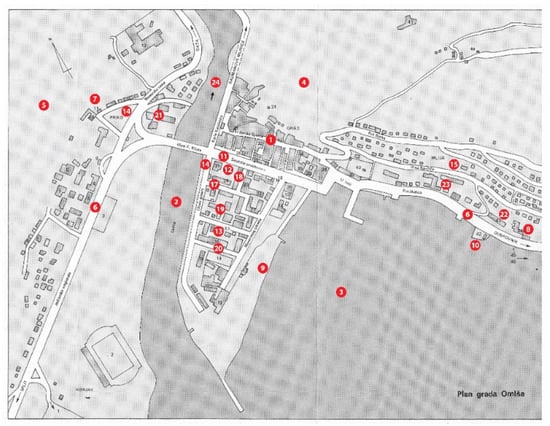
Figure 3.
Aerial photo Map of the town of Omiš, 1984, with toponyms and realisations of Frano Gotovac, Zoja Dumengjić, Ivo Radić, and Josip Vojnović: 1. Historical core of Omiš. 2. The River Cetina. 3. The Adriatic Sea. 4. Mount Dinara. 5. Mount Poljica. 6. Adriatic Highway. 7. St. Peter’s Church. 8. Franciscan Monastery. 9. City beach. 10. Shipyard. 11. Fošal. 12. Prince Miroslav Square. 13. Punta. 14. Priko. 15. Mlija. 16. Frano Gotovac: “Dalma” Department Store in Fošal. 17. Frano Gotovac: Block of flats adjacent to the department store. 18. Josip Vojnović: Block of flats on Prince Miroslav Square. 19. Frano Gotovac: Block of flats in the central part of Punta. 20. Ivo Radić: Blocks of flats in the south part of Punta. 21. Frano Gotovac: Housing estate in Priko. 22. Zoja Dumengjić: Primary Healthcare Centre in Mlija. 23. Frano Gotovac: Housing estate in Mlija. (source: Katušić, I. Omiš—Historical and Tourist Guide of Omiš Municipality. Omiš: “Dalma” OOUR Hotels Omiš, Board of Culture of Omiš Municipality, Omiš Tourist Board, Society for the Preservation of Cultural Heritage Omiš. 1984. Appendix: Map of the town of Omiš, and authors’ numeration).
Between the Second World War and the Homeland War, Omiš saw intense growth, spreading to the southeast, southwest, and northwest of the historical core, primarily due to a considerable increase in population, drawn to the city by the development of industry and tourism. The early 1960s saw the spreading of Omiš outside its historical core. The development was chaotic and unplanned. Family houses were built on valuable lots. In 1967, an idea for the urban plan, called Omiš 1990, drawn by the architect Frano Gotovac, was drawn, basically representing a general city plan and containing a regulation design [27]. The plan underwent the legal procedure but was not adopted. However, based upon it, Gotovac proposed several regulations of urban areas. The Municipality of Omiš commissioned a General Urban Plan from the Institute of Urban Planning of Dalmatia in Split, and it was adopted in 1973 [28] (pp. 177–182). In architectural terms, the most significant contribution was made by Frano Gotovac, an architect who devoted his entire life and oeuvre mostly to Split. Another architect from Split, Ivo Radić, made a special contribution to Omiš in his domain, as well as Zoja Dumengjić, a Russian immigrant born in Odessa on the Black Sea. Therefore, their experience of living at the sea (the Adriatic and Black Sea, respectively), along with the modernist vocations of mature authors, significantly contributed towards the forming of the City of Omiš as viewed from the open sea. The above architects all graduated from the Technical Faculty in Zagreb. All of the aforementioned architects succeeded in creating remarkable modernist architecture, in which the spirit of the Mediterranean is integrated, and the tradition is reinterpreted and incorporated into the principles of modern architecture.
Scientific research so far has not focused upon the modernist architecture in Omiš as a separate subject. Although some of its realisations have been analysed or briefly illustrated within the author oeuvres of the architects Frano Gotovac and Zoja Dumengjić [28,29], no systematic presentation or evaluation of the urban development and modern architectural realisations of Omiš has yet been published.
This paper, for the first time, deals with, explores, and evaluates urban plans and the layers of modernist architecture pertaining to various typologies, realised in the Socialist era, undoubtedly enriching the historical City of Omiš; particularly those constructed at the outskirts of the growing city. Due to intensive industrial and tourist development, the city has been rapidly growing, spreading to its southeastern, southwestern, and northwestern outskirts.
The paper analyses the most significant realisations of residential architecture, the modernist public city square, the department store, and the healthcare centre, as well as some so far unrealised projects. Electrification has enabled intensive industrial development, also resulting in an increasing growth of urbanisation and the tourist industry. The emphasis is laid on the characteristic features of modernist architecture during the Socialist era, also presenting some, so far insufficiently explored and unpublished, projects in the City of Omiš.
The paper is also aimed at interpreting the principles and tenets of modernist architecture, harmoniously incorporated into the environment with its specific climatic features, the quality of the landscape, and the elements of traditional architecture, which have been transposed and reinterpreted by individual creative procedures of modern architects. We have tried to interpret the modernist principles within the context of a city of exceptional beauty in both its natural and historical features.
Having noticed the significance of modernist architecture and urban planning within the exceptional natural landscape and as a superstructure of the existing historical core, as well as a lack of systematic research on the architectural and urban heritage of the Socialist era, the authors have undertaken research comprising both primary and secondary sources. The published studies have been supplemented by additional field research and have been analysed and evaluated within the context of the city’s development. By exploring and analysing the primary sources contained in the archives, some unknown design solutions have been discovered, which have so far gone unexplored or have not been properly evaluated; we have been able to observe the tendencies and grasp the wider picture of the mature architectural modernism in the City of Omiš.
All the works herein have been analysed within their original context and with respect to the current situation. A new insight has been obtained by field research in situ, as well as by studying the planned and realised urban facilities in Omiš. By comparative analyses of the works designed by the same architects in the nearby Split, their specific characteristics have been singled out, as well as the references to the traditional architecture of Omiš. Sustainability actually represents the elements of rationality in the designing of both traditional and modern architecture, thereby anticipating the current trends of today’s architecture. The analysis of modernist architecture in Omiš in this paper will be focused upon the extensions of the historical city core towards the southwest (the area of Punta), northwest (the area of Priko), and southeast (the area of Mlija).
The original research includes the study of archives and field work with photography. With the aim of thoroughly presenting the architectural achievements of the studied period, an extensive list of works is provided.
The case studies are framed in a comprehensive (tabular) catalogue of works in the city. Facts included are those of the author, year, size, technique, state of preservation, original use, current use, etc., (Table 1, Table 2 and Table 3).

Table 1.
Comprehensive (tabular) catalogue of works in the city—Punta area (source: author’s archives, Map of Punta (based on: https://oss.uredjenazemlja.hr/map, accessed on 15 March 2023), and authors’ numeration; photography of building 8, photo taken by the author 2008 and photographs of buildings 1–7, 9–13, photo taken by the author 2023).

Table 2.
Comprehensive (tabular) catalogue of works in the city—Mlija area. (source: author’s archives, Map of Mlija (Based on: https://oss.uredjenazemlja.hr/map, accessed on 15 March 2023) and author’s numeration; photographs of buildings 1–6, photo taken by the author, 2023).

Table 3.
Comprehensive (tabular) catalogue of works in the city—Priko area. (source: author’s archives, Map of Priko (Based on: https://oss.uredjenazemlja.hr/map, accessed on 15 March 2023) and author’s numeration; photographs of buildings 2–3, photo taken by the author, 2008 and photographs of buildings 1, 4–14, photo taken by the author, 2023).
The objective of this research is to frame the phenomenon from a historical and technical point of view following two perspectives: local and European.
The specific case study research includes the most prominent late modern realisations of Omiš within the urban core of the city. Modern realisations of residential use and preschool, primary, and secondary education buildings refined the urban fabric of Omiš during the second half of the 20th century.
5. Punta Area
The Peninsula of Punta, located to the southwest of the historical city core, saw the beginning of intensive construction in the late 1960s. Before that time, there were only a few Art Nouveau buildings from the early 1900s and an industrial plant—“Galeb” knitwear factory far to the southwest. In the original peripheral industrial zone of the factory, in accordance with the urban plan concerning the Punta Peninsula, construction of a hotel (zone T1) was proposed. [30,62]. The subsequent construction along Fošal Street was mainly inserted between the existing buildings, forming the street façade and, at the end of the street overlooking the River Cetina—Duke Miroslav Square. Up until the late 1980s, a number of blocks of flats, business buildings, and schools were built, designed mostly by Split architects.
The first buildings built on Punta at the end of the 1950s were erected for the employers of the Municipality of Omiš and for the accommodation of workers working on the construction of the Hydroelectric Power Plant Split in Zakučac. As warned by one of the councilors of the municipal assembly, the construction of these buildings started before the adoption of the Regulatory Plan of the City, on the basis of which construction permits were to be issued. He added that the buildings were being erected on the fertile alluvium of the river and wondered if the decision to build was correct [63] (Figure 4). Most of the councilors, however, supported the construction; therefore, the northern plots of Punta were soon filled (until the beginning of the 1960s), and the central part (south of “Galeb” factory) was filled by the end of the 1980s.
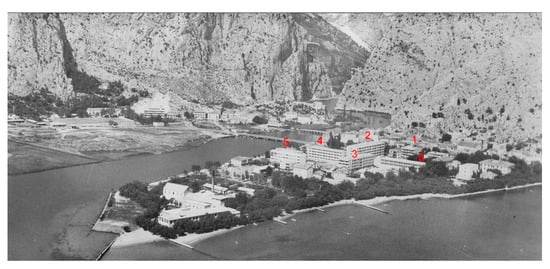
Figure 4.
Punta area in the 1960s with first residential buildings (marks 1–6 in the photograph match with the marks of said buildings in the catalogue of works in the city) (source: author’s archives, unknown author).
5.1. Prince Miroslav Square, Block of Flats by Architect Josip Vojnović (1962), Block of Flats and “Dalma” Department Store by Architect Frano Gotovac (1968)
One of the first considerations concerning the extension of the city in the mid-1950s was the development of the extreme northern and yet unurbanised part of the Peninsula of Punta. The lot is bordered by the River Cetina in the northwest, and Fošal Street and the Medieval city in the northeast. Close to Fošal Street, there is a bridge connecting the old part of the city with new, urbanised areas to the northwest of the river. For this area, the architect Josip Vojnvić proposed a new public square, bordered on three sides by buildings of various designs and heights. Since he was focused on a residential three-storey building (anagraphic designation: Omiš, 4, 6, 8, 10 Joko Knežević Street) in the southeast part of the square, built in 1962, the arrangement and design of the remaining space was presented by a perspective sketch, not clearly or precisely delineating its purpose. Based upon this sketch, Vojnović’s idea for the design of the entire lot may be discerned. He seems to have envisaged the square being planted with trees, thereby ensuring that residents might experience a pleasant time spent in the shade. The lower buildings, probably of social or commercial designation, were proposed along Fošal Street and the historical core, as well as alongside the river. A hall with an auditorium of the House of Culture [32], laid longitudinally along the river, stands out because of its design and volume. Its ground plan is a trapeze and its façades are rounded. The southwest part of the square, boasting good insulation, Vojnović leaves partly open, with views directed towards the yet undeveloped areas of Punta, and, further away in the distance, towards the river’s mouth and the sea. Inside the buildings forming the square’s northeast façade, the author has formed a covered pedestrian passage, in order to connect the square with the historical core.
The completed residential block (Figure 5, Figure 6 and Figure 7), shaped as a rectangular prism (cuboid), is a URBS-1 typefied project, designed according to functionalist forming principles [33]. Studied work 1
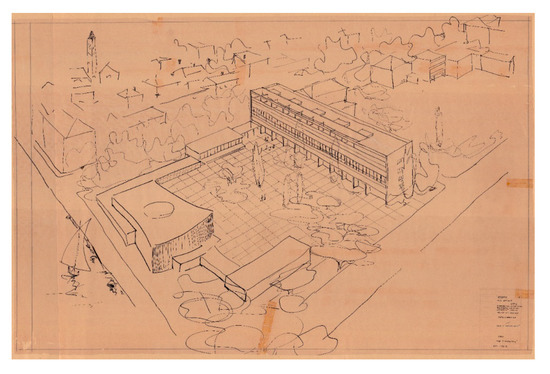
Figure 5.
Perspective representation (preliminary sketch) of URBS-1 block of flats and the surrounding square, architect Josip Vojnović. View from the west. Sketch by Vojnović (source: National Archives in Split, HR-DAST-119, Urban Planning Institute of Dalmatia—Split, sign. 2.7., 275/po Residential-commercial building type URBS-1 Omiš 1959).

Figure 6.
URBS-1 block of flats, plan of the first floor, architect Josip Vojnović (source: author’s archive, redrown by the author in 2023 from a layout obtained from the National Archives in Split, HR-DAST-119 Urban Planning Institute of Dalmatia—Split, sign. 2.7., 275/po Residential-commercial building type URBS-1 Omiš, 1959).
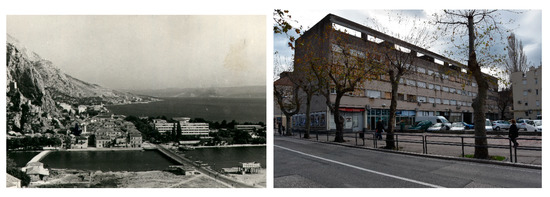
Figure 7.
URBS-1 block of flats, architect Josip Vojnović. View from southwest, original look (left) and view from north, present look of the building (right) (source: author’s archive, unknown author (left) and photo taken by the author, 2020 (right).
The longitudinal façades are articulated with strip windows, whereas the gable ones—facing the historical core and the Peninsula of Punta—are completely closed. Communication between the square and the spaces on the southeast of the building are rendered impossible by the position and the design of the building. It is precisely due to this inadjustability to the environment, views, and orientation, as well as due to the size and its closed quality, that the building came to be known as a military barracks by the citizens of Omiš. Such typefied buildings were constructed on several locations in Dalmatia (Split, Omiš, Šibenik, and Ploče) on the occasion of constructing new city areas further away from the historical core, where their design qualities in this context have become fully noticeable. These residential settlements, with their slender rectangular buildings surrounded by greenery, can be linked to Gropius’s model of high-rise slab buildings for the unrealized Haselhorst settlement in Berlin from 1929, for which Gropius experimented with the rational use of urban land. These buildings were common in residential areas around the world in the 1960s [64] (pp. 492–494).
Vojnović is a prominent representative of functionalism in Croatia. For years, he dealt with the issue of rationalization in construction when it was necessary to build a large number of cheap apartments for the market in a short time. With the topic “Rationalization and evolution of residential and communal construction in the processes of planning, organization and programming,” he received his doctorate in 1978 at the Faculty of Architecture in Zagreb [65]. His buildings of solid prismatic form derive precisely from the author’s belief in rational design. When designing apartments, Vojnović was pragmatic and very thoughtful when it came to individual functional details. He designed different types of two-room apartments depending on their level: apartments on the first and third floors are different from those on the second. Such a disposition of residential units will be reflected in the composition of the relatively long facades and the structuring of their surfaces. The final building was not built entirely according to Vojnović’s idea; the apartments are built the same on all floors, and the facade is therefore less plastic.
In 1960, soon after Vojnović, at the request of the People’s Committee of the Municipality of Omiš, the development project for the area came to be realized by the architect Ivo Radić [66]. He planned the construction along the circumference of the lot, forming a square in its centre. He placed the Culture Centre parallel to Fošal, and instead of Vojnović’s building, not realized at the time, he designed a commercial one with a series of shops. The ground floors of both buildings were recessed relative to higher floors, thereby forming deep porches oriented towards the square and Fošal. Radić designed a pedestrian passage through the ground floor of the commercial centre connecting the square to the nearby vocational school. The construction of the school was planned mainly for students from the nearby villages of Kreševo, Katuni, and Žeževica, as well as others, so that they could become qualified workers who would participate in the construction of Omiš [11]. In The Archives of the City of Omiš, the designs for the school (today Jure Kaštelan High School, anagraphic designation: Omiš, 2 King Tomislav Square) have not been preserved; therefore, the author remains unknown. The fire station building was located in the southwest corner of the lot, and the pupils’ dormitory on the southwest side of the street, extending along the lot and separating it from the remaining parts of Punta.
Since Radić’s proposal never came to be realised, and Vojnović’s building was constructed in 1962 at the request of the People’s Committee of the Municipality of Omiš, the design of this area was entrusted to the architect Frano Gotovac, who completed it during 1966–1968. He designed and constructed the Dalma Department Store (anagraphic designation: Omiš, 2 Fošal) in the north, in the corner of the lot next to Fošal and the River Cetina. In the southwest part of the lot, Gotovac built a residential three-storey building (anagraphic designation: Omiš, 3, 5, 7, 9 Vladimir Nazor Street). The central area between the residential blocks and the department store was left untouched, with the architect envisaging there a square grown with greenery, affording a view towards the historical city core.
By designing a commercial building, the architect showed an interest in sculptural components of the architectural language, explaining this decision by the fact that “such facility is supposed to attract customers and by its likeable and pleasant appearance must justify its very existence” [67] (p. 50) (Figure 8, Figure 9 and Figure 10). Studied work 2
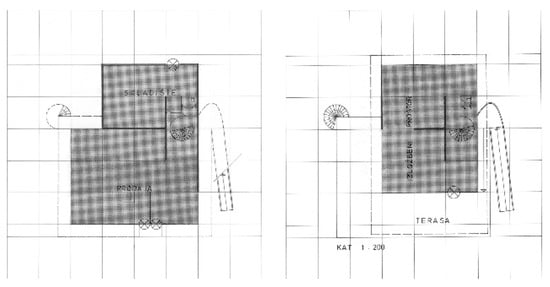
Figure 8.
“Dalma” department store, plan of the ground floor (left) and the first floor (right), architect Frano Gotovac. Sketch by Gotovac (source: author’s archives, detailed design of the building T.D. 33/66, 1966).
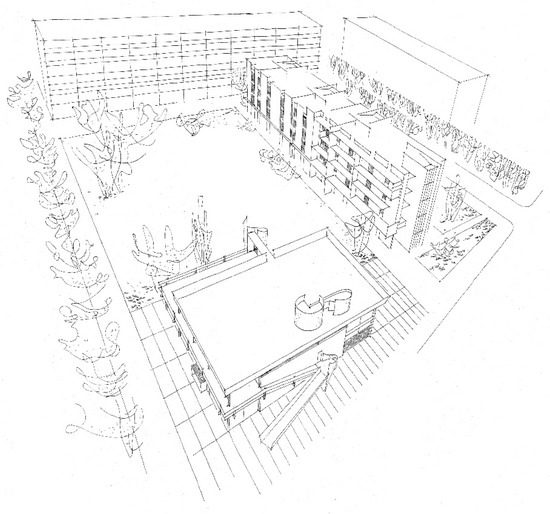
Figure 9.
Perspective representation of “Dalma” department store and the block of flats, architect Frano Gotovac and the URBS-1 block of flats (in the background), architect Josip Vojnović. View from the north. Sketch by Gotovac (source: author’s archives, detailed design of the building T.D. 33/66, 1966).
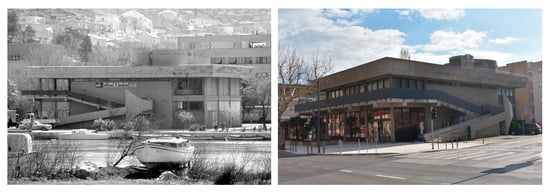
Figure 10.
“Dalma” department store, architect Frano Gotovac. View from the west, the original look (left) and view from the north, present look of the building (right) (source: author’s archives, unknown author (left) and photo taken by the author, 2023 (right).
He approached his work on this building, close to the historical core and clearly visible from various angles and from a greater distance, with utmost care. The outer shell of the regular prism-shaped building is dominated by a sculpturally formed ramp (Figure 10) and spiral staircase on opposite sides. The design of these sculptural elements points to Gotovac’s familiarity with the Brazilian Pavilion and architects Oscar Niemeyer, Lúcio Costa, and Paul Lester Wiener, whose work at the 1939 New York World’s Fair entailed a sculpturally shaped ramp in the foreground [68] (p. 278). The free fluid space of the building, which enables the skeletal supporting system, evokes associations with Le Corbusier and his “five points” [68] (p. 171). The shape of the concrete columns of the cruciform floor plan resembles the slender steel columns of Mies van de Rohe in Tugendhat Villa in Brno (Czech Republic) from 1929/1930 and in the famous Barcelona Pavilion—a German pavilion for the International Exposition in Barcelona (Spain) in 1929. The same is true of the design of the pavilion of the coffee bar on the roof terrace. The slanting annex to the roof terrace, by a strong horizontal stroke, smooths the entire composition of the department store. The skeleton of the applied supportive structure enables the designer to create a unique store space, liberating the façade of its support role. The building’s façades feature alternating glazed surfaces with walls done in concrete and brick, without ornaments or finishing, in keeping with the brutalist doctrine which advocates for an open representation of the essence of the material [28] (pp. 349–355).
The department store has undergone alterations and is different today when compared to its original state. With the change in social relations after the Homeland War, the Dalma department store ceased to operate and changed hands. Adapting the premises of the department store to his needs, the new owner divided the formerly connected space of the ground floor and first floor into two independent shopping areas. These spaces have, in turn, been partitioned several times according to the preferences of the current owners. The staircase that connected the two floors lost its function. The external appearance of the building was also altered by changing the colour of the facade and highlighting the billboards of various local companies. In the last ten years, the building has undergone several unprofessional renovations. The last “renovation” changed the colour of the facade from the usual light shade of concrete to dark grey.
The residential building is located in the southeast part of the lot, extending parallel to Fošal Street (anagraphic designation: 3, 5, 7, 9 Vladimir Nazor Street). It has three storeys and the top floor superstructure is recessed relative to the lower façades. The northeast façade, overlooking the square, is formed by means of diverse visual elements which, skilfully integrated, create a harmonious whole. The differently formed parts of the building are pronounced by a horizontal shift of the elements on the joints of variously shaped formative concepts with a view to creating a more dynamic and attractive overall appearance of the building (Figure 11 and Figure 12). Studied work 3
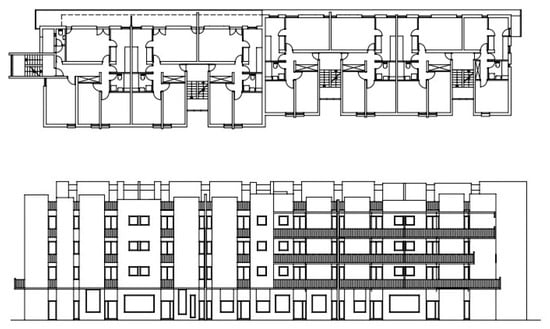
Figure 11.
Residential building, architect Frano Gotovac. Ground plan of the first floor (upper) and the north façade (lower) (source: author’s archives, assumed original state of the building drawn based on architectural measurements of the current state, 2009).
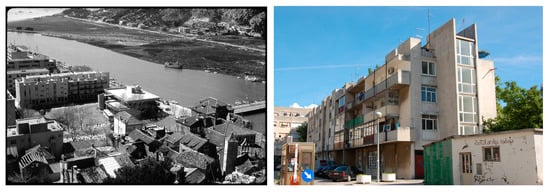
Figure 12.
Residential building, architect Frano Gotovac. View from the northeast, original look of the building (left) and view from the north, present look of the building (right) (source: the Archives of Gotovac family, Split, Hrvatske mornarice 1I, unknown author (left) and author’s archives, photo taken by the author, 2008 (right).
Gotovac was a student at the Faculty of Architecture in Zagreb. His professors were advocates of rationalism and functionalism. This is the reason why Gotovac’s first buildings were shaped under the influence of these two directions. At the beginning of the 1960s, new tendencies appeared in architecture as a response to rationalist rigor. Gotovac accepted the new directions in architecture (structuralism, brutalism, and metabolism) and the new formative means of those directions. He applies them in a special way, creating architecture with a strong author’s stamp firmly rooted in the time of its creation [68] (pp. 276, 290–291, 306–307).
His buildings are created by adding smaller volumes to the basic structure of the building, such as the method of adding volumes that we notice in Romanesque churches. Gotovac builds houses using concrete and claims that “an architectural object is actually as valuable as its (real) values in concrete. Only then can one feel the real plasticity in the deep shadows, like a real primordial spatial sculpture” [69]. During his entire working life, Gotovac was preoccupied with the question of breaking down the boxy volume and breaking down the façade fabric into smaller segments, especially in the case of long buildings. He solved the problem by grading the volume of the building by height and by dividing the facade into smaller units with vertical strips of windows and full wall areas.
The apartments he designed are functional, always with a clear division into the day and night part of the apartment. Many apartments have access to the loggia or balcony, which can be used for most of the year due to the mild climate in the Mediterranean. Gotovac’s apartments abide by the rules for designing residential and communal constructions in terms of required contents, used building materials, room surfaces, apartment equipment, etc. Gotovac opposed these programs, considering them to be in contradiction with the freedom and creativity of the author, and wrote about it in the daily press [70].
Similarly, Gotovac designed several buildings in Split (7, 9 Washington Street; 2, 3, 4 Ivan Lozica Drive and 7, 9, 11 Pojišan Street; 1-11 Karaman Street) and Omiš (10, 12, 14, 16, 18 Fra Stjepan Vrlić Street), in the period between 1965 and 1970, by articulating the building’s volume with smaller segments employing either vertical or horizontal volume shifts [28] (pp. 100–123, 75–91, 202–209). The parts of the façade which are close to the river are formed by long horizontal strokes of balconies and loggias, and the remaining parts by the stringing together of vertical strokes, consisting of full walls and French windows.
Compared to its original state, the building has undergone some changes. The external appearance has been altered with different additions and the enclosing of loggias and balconies in glazing or solid material. This way, the exterior spaces of apartments have become part of their interior and are most often used as extensions of kitchens and living rooms. Over time, the tenants have also made changes to the original floor plan of their apartments. They divided spaces to obtain more rooms or, in other cases, demolished the partition walls between the rooms. In order to obtain a unique open space, living rooms and kitchens, for example, have been connected to dining rooms. A similar fate is shared by other analysed buildings in Omiš.
Gotovac initially designed a square which ‘’…had been envisaged and created as a sort of extension of Fošal Street in every way: functionally and visually—to let it spread and breathe, and to fill it with adequate contents” [71]. One of the rare modernist squares in Dalmatia, Prince Miroslav’s Square has never been truly brought to its true purpose. Bordering along the northeast side of the square, several street-stands (kiosks) were placed facing Fošal Street immediately upon the completion of the department store. They have been hindering a view of the historical core, particularly the ones which the authors considered particularly valuable. For years, the square has been used as a bus station, then an improvised parking lot. Today it exists in name only because in more recent urban plans the square as a public space is totally devastated and designated solely for parking purposes. It has been intended for the kiosks to be replaced by ground floor shops, whose design has been proposed to be chosen by competition. The Urban Plan for Punta, valid since 2010, in Article 9, specifically states: “Alongside Fošal a location of several carefully designed pavilions bearing the designation K2 is planned, housing shops for the sale of various products and smaller catering facilities. These are uniquely shaped one-storey buildings to be constructed upon a public competition for design and interior equipment. The pavilions are to have flat roofs” [30,62]. The competition for a preliminary urban and architectural solution for Fošal in Omiš was announced in 2009. The first prize went to Antonija Dominović, student of architecture, and Ivana Dragoje, graduate student of architecture [72].
5.2. Residential Blocks at Punta (Architect Ivo Radić, 1978–1982)
Ivo Radić designed a semi-block (anagraphic designation: 4, 5 Punta, 1–3 Ivan Raos Square) in the central area of Punta, between the River Cetina and the major city beach. The block faces southwest and consists of two residential buildings perpendicular to one another. Their recognisable façades articulate and define the city viewed from as many as three sides from the waterfront, as well as from the river front [45] (Figure 13). Studied work 4
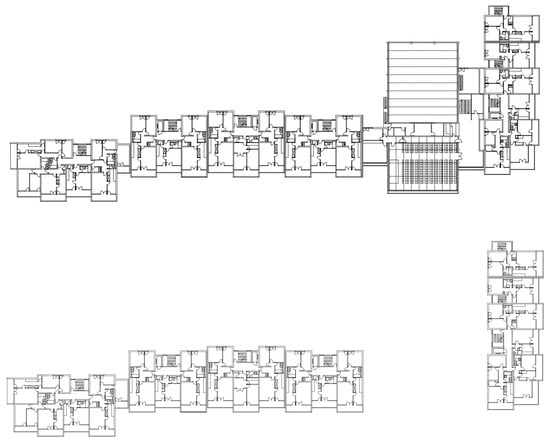
Figure 13.
Housing estate with the City Hall and the cinema in Punta, architect Ivo Radić, design of the building (upper) and the realised building (lower) (source: redrawn by the author in 2021 from a layout obtained from the National Archives in Split, HR-DAST-119 HR-DAST-119, Urban Planning Institute of Dalmatia—Split, sign. 2.7. 831-po-IV).
In the area joining the two residential wings, a grand double hall with large auditoriums, divided by communication and other accompanying facilities, was envisaged. However, unfortunately it never came to be built, so the social character and significance of Punta are missing. Such a peculiar hybrid complex, designed for both residential and social purposes, was for the first time designed by the architect Ivo Radić specifically for Omiš. This paper, therefore, presents his so far unpublished project (Figure 14).
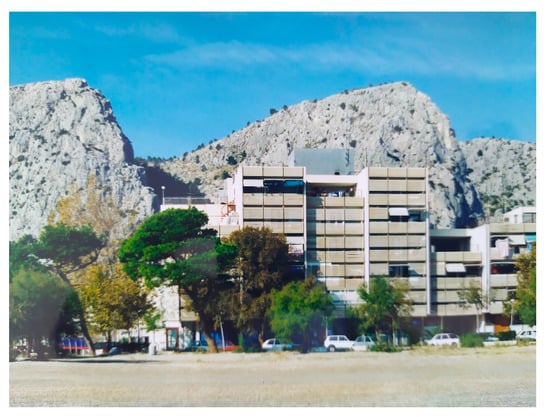
Figure 14.
Housing estate in Punta, architect Ivo Radić. View from the southwest, present state of the building (source: author’s archives, photo taken by the author, 1998).
On the site of Radić’s unrealized project for a cinema and town hall building, architects Ivan Valek and Krešimir Feletar from Zagreb designed an atomic shelter-commerical building in 1988. This, however, was also never completed [73].
Two wings of characteristic, almost typefied blocks of flats were constructed on the Peninsula of Punta, such as those Ivo Radić had already realised on a number of locations in Split, in different urban zones and at different scales. The buildings form the southwest, mostly residential semi-block on Punta, the southwest part of which accommodates several low-rise buildings pertaining to the industrial zone. The rhythm of the residential blocks determines the range of transverse support walls of varying height: from three to seven storeys.
The flats are horizontally laid (with the exception of the flat located along the west gable façade), with the living areas oriented towards the peripheral sea and river surfaces. The living areas are fitted with shady loggias and sheltered from the sun by unique shades. The white horizontal lamellas of a loose screen form the entire southwest, southeast, and west façades of the building, while the fence parapet and shades rotate in the upper zone along the horizontal axis. The three different positions ensure a gradation of the strong insulation, as well as the gradation of privacy, shielding the residents from being viewed from the street.
The north bedroom part of the flat is less exposed to strong sunlight and is, therefore, characterised by sliding partitions extending along the full height of the flat. This represents a peculiar space-defining theme as is characteristic of a substantial part of Radić’s oeuvre: almost typified design of residential blocks, as can be found in various urban complexes in Split (1965–1968. Residential-business building, 2, 3, 4, 5, 6 Prince Branimir Seafront; 1972–1974. Block of flats (Split 3), 1–29, 31 Boris Papandopulo Street (1976. Town Planning Institute annual award); 1972. Residential-business building, 5, 7, 9, 11 Zoranić Street; 1988.-1989. Residential-business building in 1 Tin Ujević Field; 2, 2a Zrinjsko-Frankopanska Street; 1, 3 Petar Svačić Street) [74] (pp. 183–185), [75] (p. 201, 229, 223, 267), [76] (p. 115). A double façade shell, enabling adequate protection from strong southern sunlight, seems to represent a theme of the Mediterranean and a number of modernist buildings, whose basic characteristics appear to merge in this particular case.
Throughout his life, Radić remained consistent with modernist expression without going into the postmodern formal discourse. Radić reinterprets the clean surfaces and simple volumes we know from Mies van der Rohe [64] (pp. 365–373) in his first skyscraper projects in Split from the mid-1960s (skyscrapers in Spinut at 2, 6, 8 Seven Kaštela Street and Bol at 35, 53 Trst Street, 60 Homeland War Street, 43 Freedom Street). Mies’ influence is also present in the design of long residential buildings, such as the analysed building in Omiš or the apartment block in Papandopulo Street in Split 3. To reduce the length of the buildings, Radić divides their facades into smaller segments using transverse load-bearing walls which stick out. The narrow and tall parts of the façade, with the proportions of a skyscraper, are covered with an airy curtain of horizontal brisoleils, which gives the façade a Miesian character. In contrast to the static nature of Mies’ creations, Radić’s buildings are characterized by a kinetic element in the composition of the facade. Different possibilities of adjusting the brisoleils give a number of variations in the appearance of the façade at any given moment. When you add to that the changes in insolation during the day and different seasons, the series of variations becomes even more pronounced.
Ivo Radić was consistent in implementing and elaborating his creative ideas, applying brisoleils on most of his buildings. This made him a recognizable author in Croatia [77] (p. 109). The correctness of his solutions is indicated by the fact that the brisoleils have been left intact to this day and are used even on recent buildings by younger contemporary authors in the Split area.
In the context of Croatian architecture, Radić’s buildings can be compared to the residential complex in Laginja Street in Zagreb by the architect Ivo Vitić in terms of the sliding brisoleils but excluding the coloured facade [78].
In the context of European creativity, it is necessary to highlight the specific thinking of the Spanish architect Coderch, who on the ISM building from 1951 in Barcelona opened the facade with shutters covering the entire height of the opening, i.e., the floor [68] (p. 341), [79,80]. The Italian architect Ignazio Gardella used horizontally movable brisoleils on a residential building from 1951 in Alessandria [81] (p. 501). These brisoleils are similar in shape to those used by Radić on the northern façades of his buildings.
6. Mlija Area
The area of Mlija, located on a slope to the southeast side of the historical core, was sparsely built until the late 1960s. A church dating from the 15th and 16th centuries in the old Omiš cemetery, the Franciscan Monastery, and the church of Our Lady of Carmel were the only buildings southeast of the historical core for a long time. The shipyard of Omiš, in which traditional wooden boats are still being built, is located on the seashore.
6.1. Primary Healthcare Centre (Architect Zoja Dumengjić, 1957–1959, Realization of Stage One)
The Primary Healthcare Centre is located (anagraphic designation: Omiš, 2 Mlije Way—stage one, south wing) at the foot of Mount Dinara in Omiš, just above the Adriatic Highway and the coast (Figure 15). Studied work 5
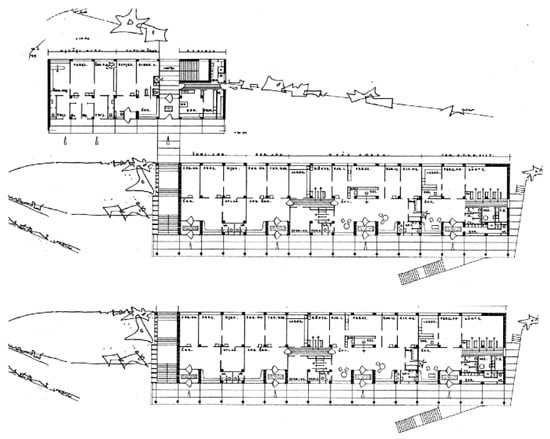
Figure 15.
Primary Healthcare Centre Omiš (1957–1959), architect Zoja Dumengjić, ground plan of the first floor, original project from 1957 (upper) and realized first phase of the project from 1959 (lower) (source: Barišić Marenić, Z. 2007, p. 267).
The architect Zoja Dumengjić, in the design of the original project, articulated the complex with two wings parallel to the terrain layers, the coastline, and a busy motorway—the Adriatic Highway. This work represents one in a series of six similar medical centres designed by the architect in the 1950s and 1960s: the medical centres in Kutina and Ploče, as well as Črnomerec, Trnje, and Medveščak in Zagreb [29] (pp. 82–87). The longitudinal wings are set apart from each other so as to ensure a view of the sea from the northeast wing. By rationalising the functional construction of the building in a warm Mediterranean climate, the author reduced the system of corridors. The doctor’s practice rooms were oriented towards the northeast and, as well as the areas of internal waiting rooms, the accompanying utilities, and the individual southwest entrances, are located in a linear manner along the longitudinal axis. The role of outer access corridors and internal passages is taken over by the southwestern floor gallery and the ground floor porches. Similar to decks aboard a ship, they also represent waiting areas of the doctor’s practice rooms.
The southwestern shell is articulated in layers, both functionally and in terms of form. It is enriched with an outer gallery system, serving as a communication point. The façade shell is drawn in behind a steel colonnade, shielding it from the strong sunlight and the heat in the summer. On the gallery floor there are rooms containing windshields, sanitary facilities, and waiting rooms, providing an impressive view of the south. The overlight is further designed in order to ensure natural ventilation for the internal spaces of the waiting rooms located on the upper floor (Figure 16).
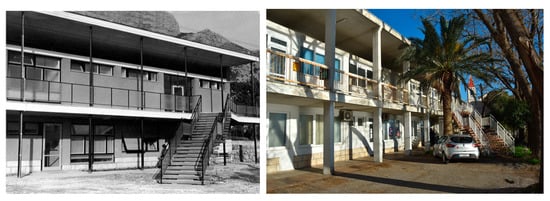
Figure 16.
Primary Healthcare Centre Omiš (1957–1959), architect Zoja Dumengjić, southwestern façade, original look (left) and present look (right) (source: Barišić Marenić, Z. 2007, p. 267 (left) and author’s archives: photo taken by the author, 2023 (right).
The access to the floor gallery and the northeast wing has been made possible by an outer northwest staircase located in the gable zone, as well as a staircase in the recess of the main southwest wing, parallel to the access driveway from the Adriatic Highway and separated from the complex by several positions and a high wall plated in stone.
Although two parallel wings were originally designed, due to modest financial resources, only the first stage—the southeastern wing of the health centre—was built. The north wing was not constructed. The broken-down project of the health centre allowed for staged construction and the use of open external connections between porches, galleries, and staircases—something that is possible in the warm Mediterranean climate. This reduces the price of construction, heating, and cooling costs, enlarges the space of inner and outer waiting areas, and reduces the possibility of infection in internal waiting rooms.
A reinforced concrete skeleton structure and mezzanine panels were used for the construction. The infill walls are made of brick, and the colonnade of slender columns of the southern porch is made of steel. The cladding of the plinth and side walls is made of stone, and the railings are made of glass. All of the above are well-known elements of the work of architect Zoja Dumengjić, who in that period was an established expert in the field of healthcare architecture.
Today’s condition of the health centre is degraded. The original layout has been changed. The corridor-less system of the waiting room on the first floor has been impaired, and a number of individual entrances were used for individual groups of clinics. As a result, the façade was also changed: the window openings and larger fenestration areas have been partially reduced. Cracks are also visible, probably due to the great earthquake in Makarska in 1962, because at the time when the building was designed, seismic calculations were not relevant (applied after the devastating earthquake in Skopje in 1963). The southern slender steel colonnade was turned into reinforced concrete columns, which, on the upper floor, have also been further reinforced in their top segments. The original colours, which was marked by a scale of light tones, light ochre, and burgundy and anthracite, were replaced by white and light yellow. The glass fence was replaced by a steel one. The wooden black and white carpentry was replaced with white PVC carpentry. The mosaic tiling of the floor gallery and the staircase has been preserved in its original form. The fact that the building is not under protection has led to a series of inappropriate interventions which have degraded the original state.
Architect Zoja Dumengjić’s work was shaped by modern architecture, primarily by the creations of Bauhaus, Le Corbusier, and Russian Constructivists, but also by Alvar Aalto, especially his sanatorium in Paimio (1929–33). It is on this thread that the Zagreb school of architecture was strongly based. These influences marked her entire exceptionally long creative life, from 1928 to 1980, which did not conform to the trends of postmodernism [64] (pp. 382–383), [82].
The healthcare architecture of Zoja Dumengjić, especially the tuberculosis sanatorium and the complex of the Split General Hospital (1951–1969), was strongly influenced by the anthological work of Alvar Aalto—the tuberculosis sanatorium in Paimio, west of Helsinki, Finland (1929–1933). With its broken-down composition, the building is subordinated to its forest surroundings and the goal of reaching optimal orientation with an emphasis on care for the patient.
6.2. Residential Area at Mlija (Architect Frano Gotovac, 1968, 1969–1972)
The residential area of Mlija is located on the sunny south slope of Omiš Mountain of Dinara, to the southwest of the Healthcare Centre and the Franciscan Monastery. Although only partly completed according to Gotovac’s urban regulation of the area of Mlija dating from 1968, it significantly contributes towards the forming City’s view from the sea and the Peninsula of Punta [28] (pp. 190–215), [83]. The architect Gotovac proposed a densely constructed complex, consisting of four residential buildings housing a total of 182 flats (Figure 17 and Figure 18).
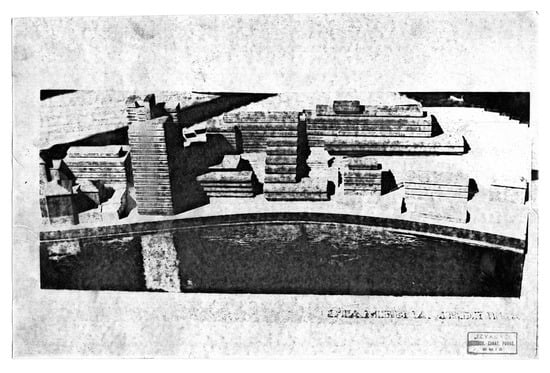
Figure 17.
Housing estate in the area of Mlija, architect Frano Gotovac. View from the west (source: The Archives of the City of Omiš, Minutes of the Fifteenth Session of the Omiš Municipality Assembly, held on 20 February 1969, item: Regulation of the Residential Block Mlija in Omiš).
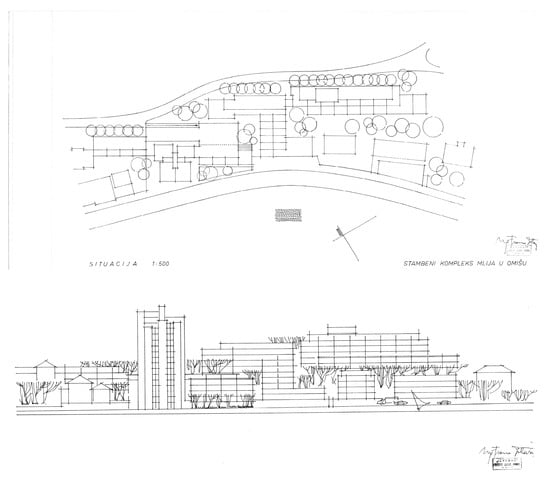
Figure 18.
Housing estate in the area of Mlija, architect Frano Gotovac. Ground plan (upper) and view from the sea (lower) (source: The Archives of the City of Omiš, Minutes of the Fifteenth Session of the Omiš Municipality Assembly, held on 20 February 1969, item: Regulation of the Residential Block Mlija in Omiš).
The terraced central building and the one on the northeast side of the area were constructed in accordance with the regulation. The residential block in the southwest part of the area lies alongside the Adriatic Highway and only represents half of the entire project, whereas the residential tower, flanking it from the west, never came to be realised. The tower block represents an almost typefied solution designed by Gotovac in several locations and realised in two locations in Omiš and one in Split. In 1973 and 1974, two blocks of flats were constructed in the area of Punta in Omiš (1 Joko Knežević Street), whereas, in Split, three tower blocks were erected in the area of Spinut (4, 6, 8 Karaman Street). These buildings share similar ground-plans and layouts, but differ in height, ranging from four to fifteen storeys. In 1978–1981, the same pattern was applied by Gotovac in designing vertical lamels in the area of Sutrojica in Split which, however, never came to be realised [28] (pp. 45–48, 92–97) (Figure 19 and Figure 20). Studied work 6

Figure 19.
Housing estate in the area of Mlija, architect Frano Gotovac. View from the west, original look (left) and and present look (right) (source: The Archives of Gotovac family, Split, Hrvatske mornarice 1I, unknown author (left) and and author’s archives, photo taken by the author, 2023 (right).
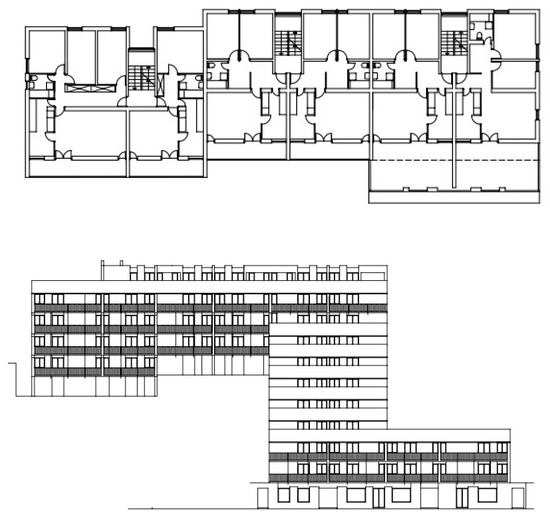
Figure 20.
Housing estate in the area of Mlija, architect Frano Gotovac. Ground plan of the eighth floor (upper) and south façade (lower) (source: author’s archives, redrawn by the author in 2008 from a layout obtained from the Archives of the City of Omiš, detailed design of the building T.D. 1/67 PO).
The terraced building, dating from 1969/1970 (anagraphic designation: Omiš, 10, 11 Skalice Way/Adriatic Highway/and 4, 6, 8 Fra Stjepan Vrlić Street) represents a rare example of this type in Dalmatia, although the slanting terrain configuration is almost ideal for this type of construction. Many historical Dalmatian villages and towns were built on the slopes of hills and mountains, parallel to the terrain layers. Professor Ivo Babić discusses the continuity of terraced construction in Dalmatia. This tradition and construction is witnessed by numerous Medieval Dalmatian cities, and is built on hill and mountain slopes [84]. The building’s ground plan is Z-shaped, consisting of two detached wings running parallel to the coastline and the terrain layers. The wings are connected by a central five-storey terraced element. The flats’ living quarters are enriched with outdoor spaces—terraces and loggias of southwest orientation, boasting exceptional views of the Brač Channel. The pronounced horizontals of full terrace fences represent a contrast to the flickering structure of shady loggias of the two remaining wings of the building.
A longitudinal seven-storey building (anagraphic designation: Omiš, 10, 12, 14, 16, 18 Fra Stjepan Vrlić Street), dating from 1970/1971, is located in the east part of the area. Its external design bears resemblance to the shape of the building situated in Prince Miroslav Square. The author has divided the volume into two smaller, horizontally laid and detached buildings, articulating them with the application of diverse forming elements (Figure 21). Studied work 7
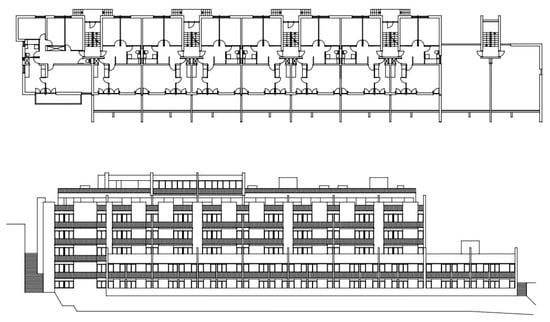
Figure 21.
Housing estate in the area of Mlija, architect Frano Gotovac. Ground plan of the first floor (upper) and south façade (lower) (source: author’s archive, redrown by the author in 2008 from a layout obtained from the Archives of the City of Omiš, detailed design of the building T.D. 7/69 PO).
The lower residential storeys are pronounced by extension towards the southwest and southeast. They are articulated with deep shady loggias with lateral walls and diversely designed fences and railings by full concrete parapets or transparent railings consisting of vertical metal rods. The four-storey corpus of higher floors is articulated with intermittent repetition with French windows and balconies or full wall masses and large glazed surfaces. The penultimate floor features a recess with a view to emphasise the top storey, protruding out of the plane of lower floors, articulated as a captain’s watchout aboard a ship heading for the high seas.
The architect Frano Gotovac attempted to realise the accent of a residential area composition, therefore reaching for a rich neo-expressionist vocabulary. The southwestern residential building (anagraphic designation: Omiš, 9 Skalice Way) located at the foot of the hill slope, situated close to the Adriatic Highway, was designed as a reverse ziggurat. The referential design is undoubtedly the Guggenheim Museum in New York, by the architect F. L. Wright (1959), and, in Croatia, the Museum of Croatian Archaeological Monuments, designed by the architect M. Kauzlarić (1954–1976) and the Pelegin Hotel in Kupari by the architect Davida Finci (1962–1963). A reverse cascade cross-section characterises the south façade of the Pulmonary Disease Pavilion, designed by the architect Zoja Dumengjić (1954–1958) (Figure 22). Studied work 8
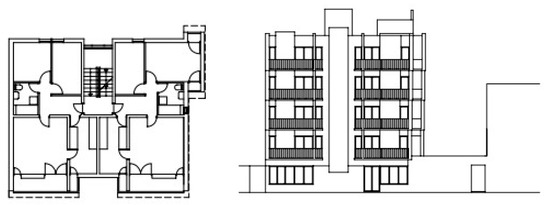
Figure 22.
Housing estate in area of Mlija, architect Frano Gotovac. Ground plan of the second floor (left) and south façade (right) (source: author’s archives, assumed original state of the building drawn based on architectural measurings of the current state, 2009).
The flats in the Mlija residential area are for the most part two- or three-room flats, with separated living spaces and bedroom units, and their almost typefied arrangement is similar to layouts of flats designed by Gotovac in the Prince Miroslav Square building, as well as in two blocks in Split (anagraphic designation: Split, 7, 9 Washington Street; 2, 3, 4 Ivan Lozica Drive and 7, 9, 11 Pojišan Street), dating from the late 1960s [28] (pp. 100–123).
7. Priko Area
The area of Priko, situated on the right bank of the River Cetina, opposite the historical core, comprised a small number of traditional houses until the early 1970s which saw the construction of a residential area designed by the architect Frano Gotovac. Somewhat further away, there is an Early Croatian pre-Romanesque church dedicated to St Peter, dating from the 9th or 10th century, prior to the foundation of the City of Omiš (Figure 23).
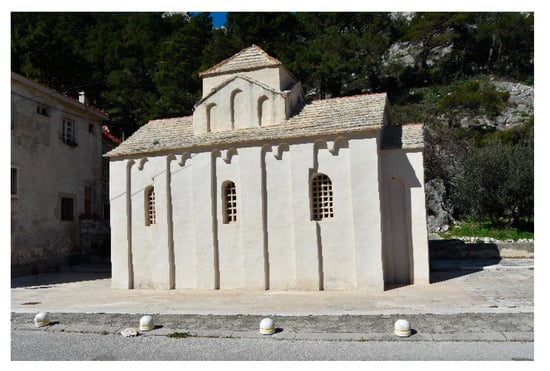
Figure 23.
Early Croatian pre-Romanesque church dedicated to St Peter, 9th or 10th century (source: author’s archives, photo taken by the author, 2023).
Residential Area in Priko (Architect Frano Gotovac, 1969, 1972–1974)
The architect Frano Gotovac, back in 1969, envisaged a small residential area, consisting of two four-storey residential blocks, a one-storey string of residential buildings, and, as yet unrealized, a one-storey atrium element [28] (pp. 215–222), [85] (Figure 24).
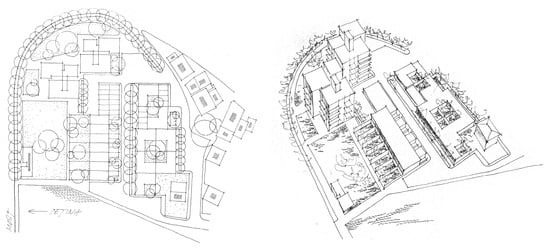
Figure 24.
Preliminary design of the housing estate “Between the two bridges” in Priko, architect Frano Gotovac. Ground plan and view from the south. Sketch by Gotovac (source: The Archives of the City of Omiš, Minutes of the Ninth Session of the Omiš Municipality Assembly, held on 22 December 1969).
The area was constructed on the narrow space of a flat terrain along the river, at the bottom of Poljica Mountain. This position offers good views of the Omiš historical core and the Peninsula of Punta across the River Cetina, and, on the other side, of the river mouth and the sea. This area is extremely well situated, in the vicinity of both the historical core and the river; therefore, the author approached his design with the utmost care. He positioned lower buildings (the residential string and the atrium building) along the riverbank, and two four-storey residential blocks at the foot of the steep rocky hinterland.
The string of residential buildings (1972) extends perpendicularly to the river in the southeast-northwest direction, and consists of seven one-storey residential units (anagraphic designation: Omiš, 6, 8, 10, 12, 14, 16, 18 Cetinska Road) and a garage block meant for use by the residents of two adjacent buildings. The residential unit lot is divided into three functional parts. The entrance part, the entry garden, and the garage take up the northeast part, the central part is occupied by flats, and the southwest part features a terrace and a garden (Figure 25 and Figure 26). Studied work 9
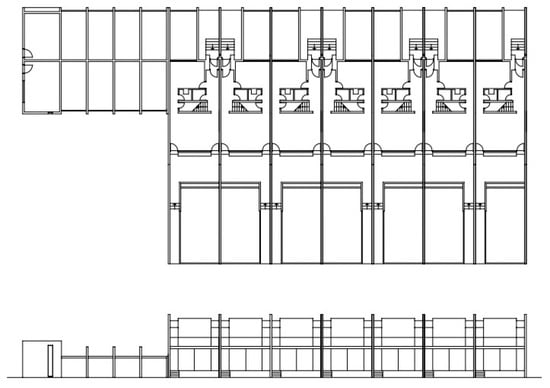
Figure 25.
Housing rows in Priko, architect Frano Gotovac. Ground plan of the ground floor (upper) and south façade (lower) (source: author’s archives, assumed original state of the building drawn based on architectural measurings of the current state, 2009).
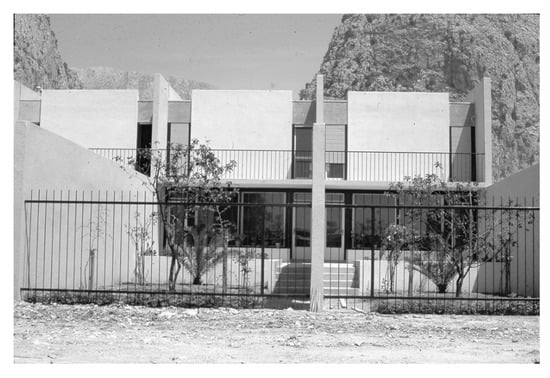
Figure 26.
Housing rows in Priko, architect Frano Gotovac. View from the southwest, original look of the building. (source: The Archives of Gotovac family, Split, Hrvatske mornarice 1I, unknown author).
The residential unit is divided into two levels: the living area on the ground floor and the bedrooms on the first floor. The ground floor living area is articulated with a transversal staircase and the sanitary facilities, dividing it from the kitchen and the dining room which are oriented to the northeast, and the living room, connected by a glazed wall to a large terrace, with a few stairs leading downstairs to the garden. The closed spaces are de-levelled in relation to the external ones, which aimed to ensure a gradual transition between the public and private spaces, as well as offering a better view of the garden and the surrounding area from the house. The composition of the string of residential houses, with simply formed cubes of flat units, enhances the fencing walls which are one storey high, extending along the entire lot (Figure 27).

Figure 27.
Housing rows in Priko, architect Frano Gotovac. View from the south, original look (left) and present look (right) (source: The Archives of Gotovac family, unknown author (left) and author’s archives: photo taken by the author, 2023 (right).
Two residential blocks (1973/1974) were proposed by Gotovac almost as a typefied project (anagraphic designation: Omiš, 2, 4 Cetinska Road). The buildings were articulated with smaller volumes and differentiated by height, about which the author says: “In such a way this building will be presented in this place, in compositional and architectural terms, lighter, relieved of its mass, thus becoming more attractive” [85]. The heights of external volumes gradually decrease towards the top of the building by one half of the floor height, being topped by the central core with the staircase. Inside of four peripheral volumes, connected to the central core by a staircase, flats of the same type and size were designed, ranging from one- to three-room flats. The flats are accessed from a platform and semi-platform of the central core, which reflect upon the building’s dynamic composition. The exterior is characterised by the vertical strokes of the walls and windows, as well as the horizontal lines of the balconies (Figure 28 and Figure 29). Studied work 10
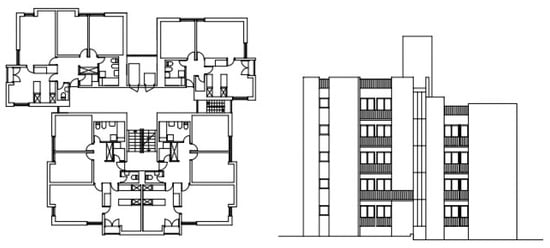
Figure 28.
Residential block in Priko, architect Frano Gotovac. Ground plan of a characteristic floor (left) and north façade (right) (source: author’s archives, assumed original state of the building drawn based on architectural measurements of the current state, 2008).
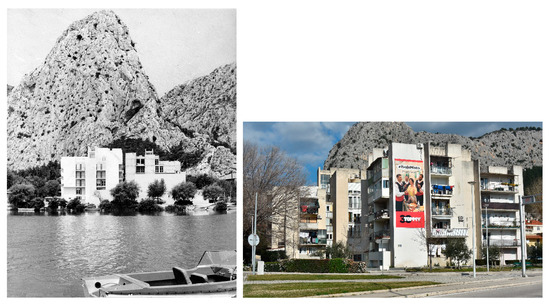
Figure 29.
Two residential blocks in Priko, architect Frano Gotovac. View from the south-est, original look (left) and view from the southwest, present look (right) (source: The Archives of Gotovac family, Split, Hrvatske mornarice 1I, unknown author (left) and author’s archives, photo taken by the author, 2023 (right).
8. Conclusions
The abstract visual quality of the mature works of the Croatian modernist architects is particularly perceivable in Omiš. On the outskirts of the small historical city at the mouth of the River Cetina, the framework for modernist realisations is provided by a dramatic mountain landscape along the Cetina canyon, as well as the surface of the Adriatic Sea and the river mouth. The unparalleled landscape of the architect Frano Gotovac is reminiscent of Rio de Janeiro [27].
It is in this impressive environment that the mature authors of the Croatian architectural Modernism created their major works. They seem to have succeeded in finding innovative functional and formal solutions, thereby affirming the qualities and values of a genuine and exceptional Mediterranean climate and spirit.
Semi-public galleries and ramps of public buildings, as well as shady loggias and terraces of residential blocks represent a peculiar contact zone between interiors and exteriors, emphasizing the connection and interfusion of private and public spaces. The tenants can enjoy impressive views of the sea and river, as well as an optimum exposure to the sun, or protection from the strong insolation in the summer. In the warm Mediterranean climate of Omiš, communication areas were created by Frano Gotovac with the ramp of the department store and Zoja Dumengjić with the external porches and galleries of the Primary Healthcare Centre. The abovementioned works are characterised by a rationalisation of technical and design solutions, as well as by cutting down on expenses of heating and cooling. All of the works are additionally ennobled by impressive and exceptionally beautiful views of the sea and the river. The theme of a double façade shell has further been affirmed by the shady loggias of the residential block designed by Ivo Radić. The loose structure of horizontal lamellas of the vertically sliding shades and railings seem to articulate the theme of light and shade in the Mediterranean environment and an adequate protection from strong southern insolation, but also a gradation of privacy controlled by the tenants (by determining the position of shades and blinds) and exposure to view from public spaces. The architectural achievements seem to question sustainability—a particularly topical issue of the contemporary architecture [86] (2021 Pritzker prize winners Anne Lacaton and Jean-Philippe Vassal also designed Transformation of G, H, I Buildings, Grand Parc, 530 Units, Social Housing (with Frédéric Druot and Christophe Hutin), with an annex consisting of block of loggias, as well as living spaces added to the program and to the existing social flats, threreby ensuring sustainable solutions). Dutchman Hans Ibelings points out that the brisolei used by Le Corbusier in the Mediterranean climate could also be used in Northern Europe, for example in Glasgow and Amsterdam, cities which are not characterized by a climate rich in sunshine [79] (p. 94).
The theme of external terraces was dealt with by Gotovac in his residential arrangement, as well as his terraced structure by the sea. He varied the typologies of housing in Omiš from low-rise to a house arrangement in a row, terraced structured two-storey flats, and high-rise multi-flat blocks. Furthermore, to the south of the historical city core he designed a modern public city square, bordering it with a multi-flat residential block and a department store, characterised by a brutal rough touch of unfinished concrete. The contrasting shady background of the north makes an impressive framework, and all of the realisations have been enriched by the picturesque views of the sea and the river.
Each one of the architectural projects realised in Omiš, carefully considered and deliberated, was placed in an optimally dimensioned spatial framework. It is exactly due to the fact that the projects came to be realised in the era of socialism that the urban planning was devised in accordance with the professional standards and not necessarily the imperative of profit, which seems to undermine all contemporary efforts. An impressive picture of architectural realisations is represented by the pronounced contrast of an impressive and dramatic natural environment and a vigorous expression of the Zagreb School of Architecture. All of the aforementioned architects graduated from the Technical Faculty (today Faculty of Architecture), Zagreb University. This is interesting particularly due to the fact that Split had a number of distinguished architects who, among the first academically educated Croatian citizens in the area of architecture, graduated from Prague, embracing and cultivating the idea of Panslavism [87]. Before the first study of architecture was established in Zagreb in 1919, architects from Croatia studied in renowned European centres, such as Vienna, Paris, Berlin, Dresden, and others. However, a number of Split students decided to study in Slavic languages and the cultural environments that they obviously considered closer and more familiar.
In Croatia, the influences of the west and the east of Europe are interwoven; its northern continental part has a more pronounced influence of Central Europe, while the southern part developed more intensively under the influence of the Mediterranean. Therefore, different influences on Croatian architecture are reflected analogously.
Modern architecture was formed under the influence of European centres, namely architects Le Corbusier and Bauhaus, and at the turn of the 19th and 20th centuries, Vienna, namely architects Otto Wagner and Adolf Loos. Before the establishment of architecture studies at the Technical College in Zagreb in 1919, the first generations of academically educated architects were schooled and trained in Vienna, Berlin, Prague, Karlsruhe, Graz, Rome, Paris, etc.
At the time of the split between Western capitalist and Eastern socialist Europe after the Second World War, Croatia, within socialist Yugoslavia, remained on the border between East and West. After intense socio-political changes, the question of the expression of modern architecture was raised.
Architect Krunoslav Ivanišin stated that “Since progressive positivism is a key feature of its tradition, the theoretical views of Croatian architecture could not accept the backward dogma of Soviet aestheticians about the art of Social Realism and its so-called realistic and highly valued qualities that people can easily understand” [88].
In recent years, modern Croatian architecture is gradually coming into focus and is being presented in international circles, especially its most outstanding achievements.
On the other hand, within the Croatian professional and scientific public, the modern heritage of the second half of the 20th century is unexplored.
It is an interesting position to look at the modern architecture of Omiš as the modern architecture of socialism in the Mediterranean, that is, the Adriatic.
All analysed achievements show an extremely high standard of construction which provides users with a high and consistent standard and quality of life. Research on housing construction in Omiš from the time of socialism reveals a high standard of housing. Interior spaces are refined by adding and integrating them with outdoor spaces. Such architectural solutions make for a high quality of living in the warm Mediterranean climate. Staying outdoors is pleasant all year round. Adequate protection from insolation provided by shady loggias and outdoor galleries enables quality use of these spaces in the summer as well.
Further, while the development of tourism has been intense in the past several decades, in recent years, more and more residents of Western and Central Europe are choosing this climate for their place of living, most notably digital nomads.
Prominent architects from Split who have realized their projects within the area of Omiš, from the mid-1950s to the end of the 1970s, are Frano Gotovac, Ivo Radić, and Josip Vojnović.
Frano Gotovac (Split, 1928–Split, 1990) graduated from the Faculty of Architecture in Zagreb in 1953. After college, he returned to Split, where he spent his entire life. He worked in several companies in Split, mainly designing housing estates and residential buildings in Split and its surroundings. The most significant works for which he is known in wider cultural circles are the two residential buildings “Chinese Wall” in Spinut from 1969 and 1970 and “Krstarica” from 1974, a building for approximately 1,084 tenants in the new city district named Split 3.
Gotovac is remembered, and is still often mentioned today, in architectural circles because of his unwavering and clear stance on issues of urbanism and architecture in Split. He expressed his opinion publicly by writing articles for many years in the local daily and weekly press (Slobodna Dalmacija and Nedjeljna Dalmacija). During his working life, Gotovac struck a balance between his design and journalistic work. He wrote continuously in the local newspapers, and rarely in the professional press, so that his articles would be more accessible to the residents of the city of Split, for whom he intended the articles.
Josip Vojnović (Omiš, 1929–Split, 2008) was a Split architect born in Omiš. He graduated from the Technical Faculty in Zagreb in 1954. He was a follower of functionalism. He is a noted author of typical residential buildings that were built in the new settlements of Split around the city core—Split 2, in Šibenik, Omiš, and Ploče from the late 1950s to the mid-1960s. Vojnović’s professional interest was the construction of rational, functional buildings with the aim of meeting the housing deficit in Split and Dalmatia at the time of the sudden increase in the city’s population. Vojnović successfully led the designing, financing, and construction of Split 3, a new Split city district for 50,000 inhabitants on the eastern outskirts of the city. This construction project was realized from the end of the 1960s to the end of the 1970s and, because of it, Split became famous within the former state. Vojnović’s passion for residential construction, project management, and the organization of construction sites directed him towards scientific research. In 1978, he received his doctorate at the Faculty of Architecture in Zagreb with the topic “Rationalization and evolution of residential and communal construction in the processes of planning, organization and programming.“ In 1982, he obtained a job at the Faculty of Civil Engineering in Split, where he worked until his retirement in 1999. He is the winner of the City of Split Award (1976).
Ivo Radić (Split, 1930–Split, 2006) was an architect from Split who completed his studies in Zagreb and graduated in 1956 from the Department of Architecture within the Technical Faculty. After graduating from college, he returned to Split and obtained a job at the Urban Planning Institute of Dalmatia, where he remained until his retirement.
Although he designed hotel and catering buildings, the focus of his work was residential architecture. Radić’s recognizable residential buildings in Split vary in scale, from smaller interpolations to the megastructures of Split 3.
Radić’s oeuvre is recognizable by the brisolés he applied to almost all of his buildings. He improved their performance in accordance with the characteristics of the material from which they were made (i.e., wood, aluminium, steel). On the northern facades, he applied horizontally movable brisolés as protection from the sun. On the southern ones, he used horizontally folding brisolés which formed the entire southern part of the building—a recognizable and very successful facade solution in the conditions of the Mediterranean climate. His most significant works are those in Split—the residential complex in the area of Split 3 in Papandopulo Street (built from 1974 to 1979), the residential buildings in Meje (built from 1965 to 1966), and the residential building in Poljana Tina Ujevića in Split (built from 1987 to 1989). He is the winner of the “Viktor Kovačić” (1988) and “Vladimir Nazor” (1994) Lifetime Achievement Awards [89] and a winner of the City of Split Award (2002).
Zoja Dumengjić (Odesa, 1904–Zagreb, 2000) is the only female architect who designed in Omiš, and the only architect whose headquarters were in Zagreb. Within the framework of the Croatian architectural scene, she stands out in the field of healthcare architecture and has made an exceptional contribution alongside the architects Antun Ulrich, Ivo Geršić, and, later, Mladen Vodička. The task to design the primary healthcare building in Omiš was entrusted to her as a prominent and well-established expert in that field.
She is the first woman who managed to assert herself within Croatian modern architecture, already having established herself in the early 1930s. She completed her architectural studies at the Technical Faculty in Zagreb and formed a professional and publishing tandem with her husband Selimir Dumengjić [90]. Since the 1950s, the more prominent architect of the two became Zoja Dumengjić, while her husband devoted himself to construction programming and theoretical work. Zoja Dumengjić’s oeuvre is dominated by four hospital buildings, the most significant being in Split (1951–69), and the others being in Karlovac (1960–1976), Ogulin (1975–1981), and Koprivnica (1975–1981).
Her author’s approach was influenced by the sound executional judgments of her colleague architect Zvonimir Vrkljan (professor of building construction at the Faculty of Engineering) and the avantgarde thinking of fellow architect Ernest Weissmann. She collaborated with the latter in the international competition for the project of the Foundation Hospital in Zagreb and won first prize. Ernest Weismann worked in Adolf Loos’ studio in Paris from 1926 to 1927, and from 1927 to 1930 in Le Corbusier’s studio [74] (pp. 82–85), [91].
Zoja Dumengjić made strides in all spheres of activity of female architects in Croatia, from the first modernist realizations, award-winning tender works, and management of architectural bureaus, to being the laureate of the first “Viktor Kovačić” and “Vladimir Nazor” lifetime achievement awards [29,89].
The urban area of the city of Omiš is the only immovable cultural property of the City of Omiš which is enlisted in the Register of Cultural Properties of the Republic of Croatia (under number Z-4066).
The Spatial Plan of the City of Omiš from 2007 defined two protection zones for the historical urban area of the city of Omiš: zone A (zone of well-preserved and particularly valuable historical structures) and zone B (zone of varying degrees of preservation and value of historical structures). The buildings analysed in this scientific work, located along Fošal Street, are in the zone B area of protection [31].
Regarding the protection of modern achievements in Omiš, only a small number of these are, in fact, protected. This entails merely the planning measures for the protection of cultural monuments [30]. Only the buildings along the city street Fošal that are located in protection zone B, near the historic core, are protected by said measures. When creating project documentation for the reconstruction and renovation of these buildings, the opinion of the Conservation Department is required.
Some buildings in Omiš from the modern era have recently been renovated, but without adequate renovation projects and without consulting architects. The consequence of such unprofessional renovations is usually the wrong choice of colours on the facades, which are significantly different from the author’s original choice (part of the building of architect Ivo Radić in the area of Punta, the residential building of architect Frano Gotovac in the area of Mlija, and even a department store in Fošal Street which is located in protection zone B). The Health Center designed by architect Zoja Dumengjić in Mlija is also a bad example of renovation.
An example of excellent restoration work is the Zonnestraal sanatorium in Hilversum, Netherlands (1926–1931), a former tuberculosis sanatorium of the Diamond Workers’ Union of the Netherlands, by Johannes Duiker and Bernard Bijvoet, which could serve as a good example of future renovations in the studied area [92].
Most modern buildings require renovation due to their age. As a rule, they generally do not go through such a process and are mostly left to degradation due to weather conditions and interventions by users.
Some anthological modern residential buildings included in the UNESCO World Heritage List have undergone high-quality restoration, for example Le Corbusier’s residential building in Marseilles [93].
In the context of Croatia, only a few rare and the most prominent achievements of mature modernity have been protected and restored, for example 1958–1962 Residential complex by architect Ivan Vitić in Zagreb, 7–9 Laginja Street, 1958–1962 [94].
The mere fact of formal legal protection cannot protect a significant building from deterioration. It is important to raise the level of users’ awareness of the significance of the architecture that they use. Therefore, this work also represents a contribution to the scientific and professional literature, but also to the general public and to its sensitization for a relatively young segment of architectural heritage—modern architecture.
DOCOMOMO—the significant international organization promoting the documentation and conservation of buildings, sites, and entire districts of the Modern Movement, included Croatia within the scope of its mass housing research, in addition to a number of other European countries. As is the case with the Croatian professional literature, the focus is on the big cities—Zagreb and Split. An anthological achievement in Zagreb is also presented: the residential complex by architect Ivan Vitić, realized in Laginja Street (1958–62) [95].
All of the architectural projects realised in Omiš have led towards articulating the view of the city from the sea and the river, thereby significantly contributing towards forming a most memorable image of an Adriatic city—seafront and waterfront.
Most of the abovementioned architects who have, by their self-denying but relevant contributions, enriched and ennobled this small romantic Dalmatian town, at the same time also designed and realised their outstanding masterpieces in Split (Figure 30).

Figure 30.
Prominent architectural modernist realisations of Split. (a) Josip Vojnović: (source: author’s archives: photo taken by author, 2023). (b) Zoja Dumengjić: 1951-1969, 1959-1964. General hospital (today KBC Split), main hospital building and polyclinic (source: author’s archives, photo taken by Emir Kahrović, 2007); (c) Frano Gotovac: 1969-1971. So-called “Chinese Wall” block of flats in the northern part of the city called Spinut (source: Feđa Klarić’s archive, 6 Tončić Street, Split, photo taken by Feđa Klarić, 2013); (d) Ivo Radić, 1972-1974. Housing estate in Split 3. (source: author’s archives, photo taken by author, 1997).
Architect Josip Vojnović designed the URBS-1 type residential buildings in the residential area along Osječka Street in Split (anagraphic designation: Split, 2, 4, 6,... 22, 24 Osječka Street). The same building was built in other Dalmatian cities [75] (p. 163) [76] (pp. 41–42).
Zoja Dumengjić designed the complex of the General Hospital in Split (anagraphic designation: Split, 1 Spinčić Street, today: KBC Split at Firule) in 1951, realised gradually between 1954 and 1969 [29] (pp. 166–179), [75] (pp. 154–155), [76] (p. 98). South façades of the main hospital building and the tuberculosis pavilion make up gallery fronts which include a promenade, i.e., living room for patients, and a terrace for heliotherapy and aerotherapy.
The urban disposition of the main hospital complex is parallel with the layers of the terrain, and Cardo and Decumanus of Diocletian’s Palace, and the slanting southeastern wing anticipates the disposition of Split 3.
Split 3, a new urban complex at the eastern outskirts of Split, was planned by the Slovene architects Vladimir Mušič, Marijan Bežan, and Nives Starc (1968–1969). It is articulated with a system of parallel pedestrian streets with adjacent residential buildings that are parallel with the coastal line, with a slanting axis, thereby reinterpreting the ancient Cardo of Diocletian’s Palace.
The northern segment of the new Cardo axis is a contemporary complex of the University of Split. In the southern plot, Frano Gotovac realised a block of flats, the so-called “Cruiser” in Split 3 in 1970–1974 (anagraphic designation: Split, 6, 8, 10, 12, 14, 16 Rugjer Bošković Street) [28] (pp. 49–74), [75] (p. 226), [76] (p. 108).
Architect Ivo Radić designed many residential buildings in Split, adjusting the initial specific prototype project to various urban situations. Shady loggias with folding blinds characterise the dominant residential complex within the new urban complex of Split 3 in 1974–1979 (anagraphic designation: Split, 1–29, 31 Boris Papandopulo Street) [74] (p. 185), [75] (p. 229), [76] (p. 115).
The exceptionally remarkable and successful interventions of modern architecture in the small City of Omiš have, however, been overshadowed by major architectural achievements in Dalmatia’s central city, Split, thereby unjustly escaping the focus of research of modern architecture [74,75,76,96].
Architect Frano Gotovac made a major contribution towards the construction of Omiš in the course of the second half of the 20th century. On the other hand, the architects Zoja Dumengjić and Ivo Radić were winners of the most prestigious professional awards for their life oeuvres in the Republic of Croatia: the “Viktor Kovačić” and “Vladimir Nazor” Prizes, respectively [89]. Therefore, the projects in Omiš in the second half of the 20th century may be taken to represent a sort of compendium of modern Croatian architecture. This paper is aimed at pointing out that the theme has been unjustly neglected and unresearched to date. It also aims at re-affirming the forgotten heritage of the modern Croatian architecture, which seems to have somehow remained in the shadow of its rich historical heritage. The historical core of a small Medieval city located southeast of Split has, so typically of Croatia, lagged behind, outshone by a great neighbouring centre. This paper is a contribution towards the modern architectural heritage of Omiš and its quality of life in an exceptional natural and historical milieu, as well as an effort to diversify the heritage and the broad tourist range and potential of the Croatian south. The architectural heritage of the recent past, i.e., the 20th century, has remained neglected in comparison to the rich heritage dating back to Antiquity and even to older times on the eastern Dalmatian coast. Although modernist architecture has been mentioned by the scientific and professional literature, its richness has not yet attracted the attention of numerous tourist groups who have visited this beautiful coast. The full potential of the wide tourist range could and should be enriched by the presentation of the modern architecture, including the socialist period, as well as the often-neglected industrial architecture of the area. This is in accordance with the 1996 Helsinki Declaration of the Fourth European Conference of Ministers responsible for the Cultural Heritage [97]: “E. Sustainable strategies for cultural tourism. The growth of cultural tourism can help to develop and revitalise regions, but has the potential to exert pressure on the cultural heritage and to affect the quality of life in host communities. Cultural tourism policies and strategies must be carried further, seeking a balanced and sustainable use of the heritage which preserves its useful potential for future generations. It is important to work out specific models for the development of cultural tourism which do not duplicate the usual patterns of mass tourism” [97] (p. 45).
The tourist industry and its range of offer should exceed “beautiful sea and sun,” ennobling it by a more varied experience and including the modernist architecture layer as part of the most recent heritage.
Author Contributions
Conceptualization, Z.B.M. and V.P.J.; methodology, Z.B.M. and V.P.J.; validation, Z.B.M. and V.P.J.; formal analysis, Z.B.M. and V.P.J.; investigation, Z.B.M. and V.P.J.; resources, Z.B.M. and V.P.J.; data curation, Z.B.M. and V.P.J.; writing—original draft preparation, Z.B.M. and V.P.J.; writing—review and editing, Z.B.M. and V.P.J.; visualization, Z.B.M. and V.P.J.; supervision, Z.B.M. and V.P.J.; project administration, Z.B.M. and V.P.J.; funding acquisition, Z.B.M. and V.P.J. All authors have read and agreed to the published version of the manuscript.
Funding
The APC covered with voucher no. 6315260d9689e78e following the contract between MDPI and National and University Library in Zagreb.
Data Availability Statement
Not applicable.
Conflicts of Interest
The authors declare no conflict of interest. The funders had no role in the design of the study; in the collection, analyses or interpretation of data; in the writing of the manuscript; or in the decision to publish the results.
References and Notes
- Republic of Croatia, Ministry of Culture and Media, Immovable Cultural Assets Inscribed od the UNESCO World Heritage List. Available online: https://min-kulture.gov.hr/izdvojeno/kulturna-bastina/nepokretna-kulturna-bastina/nepokretna-kulturna-dobra-upisana-na-unesco-ovu-listu-svjetske-bastine/7244 (accessed on 20 March 2023).
- Čovjek i Prostor, Serial Publication, from 1954, Croatian Chamber of Architects: Zagreb, Croatia. Available online: https://uha.hr/dzi.php?zi=CIP (accessed on 27 March 2023).
- Arhitektura: Monthly Magazine for Architecture, Urbanism and Applied Art. Serial Publication, from 1947, Chamber of Architects: Zagreb, Croatia. Available online: https://uha.hr/dzi.php?zi=Arhitektura (accessed on 27 March 2023).
- Oris: Magazine for Architecture and Culture of Living. Arhitekst: Zagreb, Croatia, from 1999. Available online: http://oris.hr/ (accessed on 27 March 2023).
- Fundamentals Catalogue; Absorbing Modernity: 1914–2014. Koolhaas, R., Ed.; 2014 Architecture Biennale, Marsilio, Venice, 2014. Available online: https://www.oma.com/publications/fundamentals-catalogue (accessed on 27 March 2023).
- MoMA: Toward a Concrete Utopia: Architecture in Yugoslavia, 1948–1980. 15 July 2018–13 January 2019. Museum of Modern Art in New York (MoMA): New York, NY, USA. Available online: https://www.moma.org/calendar/exhibitions/3931 (accessed on 27 March 2023).
- Kovačić, V. Urbanistic Development and Architecture. In Omiš and Poljica; Domljan, Ž., Ed.; The City Museum and the Omiš Tourist Board: Omiš, Croatia, 2006; pp. 213–241. [Google Scholar]
- Kovačić, V. Omiš—Development of the Old Settlement. Master’s Thesis, University of Zagreb—Faculty of Architecture, Zagreb, Croatia, 1987. [Google Scholar]
- Vojnović, I. Conservation Elaborate for Refurbishment of Fošal in Omiš; Office of the Authorized Architect Ivo Vojnović: Split, Croatia, 2008. [Google Scholar]
- The Archives of the City of Omiš, Omiš, 6 Fošal, Minutes of the Seventh Session of the Omiš Municipality Assembly, held on 7 November 1958, item: Social plan of economic development of the Omiš Municipality from 1957 to 1961.
- The Archives of the City of Omiš, Omiš, 6 Fošal, Minutes of the Eighteenth Session of the Omiš Municipality Assembly, held on 16 October 1957.
- The Archives of the City of Omiš, Omiš, 6 Fošal, Minutes of the Fifth Session of the Omiš Municipality Assembly, held on 28 April 1958, item: Decision on social plan of the Omiš Municipality for 1958.
- The Archives of the City of Omiš, Omiš, 6 Fošal, Minutes of the Twenty-seventh Session of the Omiš Municipality Assembly, held on 5 July 1966, item: Draft program of the regional plan of the Omiš Municipality, June 1965.
- Bartulović, V. Cetina Region from the End of the World War Two to the Beginning of the Homeland War. Ph.D. Thesis, University of Split, Faculty of Humanities and Social Sciences, Split, Croatia, 2018. [Google Scholar]
- The Archives of the City of Omiš, Omiš, 6 Fošal, Minutes of the Twenty-seventh Session of the Omiš Municipality Assembly, held on 22 December 1961, item: Social plan of economic development of the Omiš Municipality from 1961 to 1965.
- The Archives of the City of Omiš, Omiš, 6 Fošal, Minutes of the Ninth Session of the Omiš Municipality Assembly, held on 28 January 1959, item: Decision on general guidelines and program for residential construction in the area of the Omiš Municipality and Decision on directing and rational designing of residential construction in the area of the Omiš Municipality.
- Vojnović, J. Technical and Financial Guidelines of a Standard Apartment; Municipal Housing Fund: Split, Croatia, 1962. [Google Scholar]
- Directions for Construction of “Split 3”; Company for the Construction of Split—PIS: Split, Croatia, 1968.
- Action Program for the Realization of Construction of “Split 3”/Second Fase of Preparation for Construction; Company for the Construction of Split—PIS: Split, Croatia, 1968/1969.
- Zorić, M. Residantial Objects—Split 3/Project Program; Company for the Construction of Split—PIS, Association of construction companies: Split, Croatia, 1971. [Google Scholar]
- Zorić, M. Project Program of Residantial Objects “Split 3”; Company for the Construction of Split—PIS, Association of construction companies: Split, Croatia, 1972. [Google Scholar]
- Directions for the Construction of Residential Buildings for the Needs of the JNA (Yugoslav People’s Army); State Secretariat for National Defence—Construction administration: Belgrade, Serbia, 1964.
- Regional Plan; URBS; Marasović, T. (Eds.) Urban Planning Institute of Dalmatia—Split: Split, Croatia, 1973; p. 49. [Google Scholar]
- Mattioni, V. Adriatic Projects: Projects of the South and Upper Adriatic: 1967–1972; Urban planning Institute of Croatia: Zagreb, Croatia, 2003. [Google Scholar]
- Bosel, C.; Kalogjera, B. Regional Plan of Split, Shankland Cox and Associates, London and Urbanistički Zavod Dalmacije, Split. 1970.
- Ciborovski, A.; Marasović, M. Project “South Adriatic”—Example of Complex Planning, Čovjek i prostor, XIV/173, Zagreb, Croatia, p. 6, 14. 1967. Available online: https://arhitekti.eindigo.net/?pr=iiif.v.a&id=10888&tify={%22pages%22:[6],%22view%22:%22info%22} (accessed on 20 March 2023).
- The Archives of the City of Omiš, Omiš, 6 Fošal, Minutes of the Twelfth Session of the Omiš Municipality Assembly, held on 24 September 1968, item: Preliminary Urban Plan “Omiš 1990”.
- Perković Jović, V. Architect Frano Gotovac; University of Split—Faculty of Civil Engineering, Architecture and Geodesy: Split, Croatia, 2015; Available online: https://www.bib.irb.hr/643491 (accessed on 25 January 2023).
- Barišić Marenić, Z. Architect Zoja Dumengjić; UPI-2M Plus and University of Zagreb—Faculty of Architecture: Zagreb, Croatia, 2020; Available online: https://www.bib.irb.hr/1112146 (accessed on 25 January 2023).
- Urban Plan for Punta. 2010. Available online: https://omis.hr/wp-content/uploads/2022/12/Odredbe-2010-13.pdf (accessed on 5. July 2021).
- Spatial Plan of the City of Omiš. 2007. Available online: https://omis.hr/wp-content/uploads/2023/01/PPUG-2a.pdf (accessed on 15. March 2023).
- The Archives of Vojnović family, Split, 1 Mihaljević Street, List of projects of architect Josip Vojnović which he personally created.
- National Archives in Split, HR-DAST-119 Urban Planning Institute of Dalmatia—Split, sign. 2.7., 275/po Residential-commercial building type URBS-1, Omiš, 1959.
- Interview with the tenants of buildings in 10 Fošal Street, Vladimir Nazor Street (address numbers 2, 4, 6, 8, 10, 12, 14) and Obala gusara Street (address numbers 2, 3) in Omiš, 8 March 2023.
- Interview with engineer Josip Vlahović in Omiš on 17 May 2008, 14 July 2010, 15 March 2023 and 22 March 2023. Josip Vlahović is a construction engineer, former employee of the construction companies “Izvađač” from Omiš and “Konstruktor” from Split. At the beginning of the 1970s, at the invitation and persuasion of architect Frano Gotovac, Vlahović started working for the Project Bureau of the construction company “Konstruktor” from Split. The office was founded by architect Frano Gotovac (after leaving “Izvađač” from Omiš, where he had worked for two years) who successfully managed it for many years. From the late 1960s until today, engineer Vlahović has been involved in the development of Omiš. He has built a vast number of construction projects designed by architects and employees of “Konstruktor” from Split, Frano Gotovac, Ranko Ružić and Stanislav Mladinić. Engineer Vlahović is from Omiš and has had strong ties with the town during all his private and professional life. Interviews with him have been very useful since he is a good connoisseur of the social and economic conditions of the City of Omiš during the time when he participated in its construction.
- Jure Kaštelan High School Archive, Omiš, 2 King Tomislav Square: Project of reconstruction and adding of the second floor.
- Interview with school employees of Jure Kaštelan High School at 2 King Tomislav Square and employees of Lovro pl. Matačić Primary Music School at 1 Punta Street in Omiš, 9 March 2023.
- Hydroelectric Power Plant “Zakučac”, Omiš archive: Partially preserved project of the Primary Music School.
- The Archives of Gotovac family, Split, Hrvatske mornarice 1i, detailed design of the Department store “Dalma” T.D. 33/66, 1966.
- Darovan Tušek’s archive, List of technical journals of company “Projektant”, 1967, no. 16.
- Interview with the tenants of buildings in Vladimir Nazor Street (address numbers 3, 5, 7, 9, 7, 9, 11) and Renko Šperac Street (address numbers 7, 9, 11) in Omiš, 9 March 2023.
- The Archives of the City of Omiš, Omiš, 6 Fošal, detaild design of the building T.D. 19/72, 1972.
- City of Omiš, Protocol, Omiš, 5 King Tomislav Square, building permit numbers of buildings in the area of Punta: Building in 12 Joko Knežević Street (UP/I-04-1710/72).
- Interview with the tenants of buildings in Joko Knežević Street (address numbers 1, 12), Punta Street (address numbers 4, 5) and Ivan Raos Square (address numbers 1–3) in Omiš, 10 March 2023.
- National Archives in Split, HR-DAST-119 Urban Planning Institute of Dalmatia—Split, sign. 2.7., 831-po-IV Residential-commercial building Punta Omiš, 1978.
- Interview with the tenants of buildings in Fra Stjepan Vrlić Street (address numbers 2, 11, 17, 19, 21, 29, 39, 31, 33, 35, 37, 41, 43) in Omiš, 11 March 2023.
- The Archives of the City of Omiš, Omiš, 6 Fošal, Minutes of the III. Session of the Omiš Municipality Assembly, hold on 4 December 1957, nationalization of the land for construction of workers’ housing above the Omiš cemetery.
- City of Omiš, Protocol, Omiš, 5 King Tomislav Square, building permit numbers of buildings in the area of Mlija: Buildings in 2, 11, 17 Fra Stjepan Vrlić Street (UP/I-04-6585/58), and building in 9 Skalice Way (UP/I-04-548/70).
- Museum of the City of Zagreb, 20 Opatička Street, Zagreb; Collection of Architectural Documents; Legacy of the architects Zoja and Selimir Dumengjić; Zoja Dumengjić legacy; folder no. 147.
- The Archives of the City of Omiš, Omiš, 6 Fošal, detaild design of the building T.D. 1/67 PO, 1967.
- Interview with the tenants of buildings in Skalice Way (address numbers 9, 10, 11) and Fra Stjepan Vrlić Street (address numbers 4, 6, 8, 10, 12, 14, 16, 18) in Omiš, 11 March 2023.
- The Archives of the City of Omiš, Omiš, 6 Fošal, detaild design of the building T.D. 7/69, 1969.
- Interview with the tenants of buildings in Glagoljaška Street (address numbers 8, 9), Cetinska Road (address numbers 2, 4, 6, 8, 10, 12, 14, 16, 18) in Omiš, 13 March 2023.
- City of Omiš, Protocol, Omiš, 5 King Tomislav Square, building permit numbers of buildings in the area of Priko: Buildings in 2, 4 Cetinska Road (UP/I-04-679/71 and UP/I-04-979/74), building in 2, 3 Četvrt Vrilo (UP/I-04-235/75), building in 5 Četvrt Vrilo (UP/I-04-94/77), building in 8, 9, 10 Četvrt Vrilo (UP/I-04-2007/81), building in 10, 11, 12, 13 Četvrt Žarko Dražojević (UP/I-04-736/82), building in 14, 15 Četvrt Žarko Dražojević (UP/I-04-1814/85), building in 6, 7, 8, 9 Četvrt Žarko Dražojević (UP/I-04-361-03/89-02/03), building in 1, 2, 3 Četvrt Žarko Dražojević (UP/I-04-361-03/91-02/15).
- I. MI. Veterans’ flats. Slobodna Dalmacija: Split, Croatia, XXX, 8614, 1972., p. 2.
- Interview with architect Stanislav Mladinić in Split, 25 June 2009 and 17 March 2023. Stanislav Mladinić was an employee of the Project Office of “Konstruktor”, a construction company from Split, from its foundation until the company’s closure in the mid-1990s after the Homeland War. He succeeded Gotovac in the management of the office and successfully led the bureau until its termination. Mladinić designed several buildings in the Priko—Vrilo area in Omiš and together with architect Frano Gotovac created an urban plan for the area.
- Interview with Miranda Tipić, office clerk from the Administrative Department for Construction and Spatial Planning—Omiš Branch in Omiš on 15 March and 21 March 2023. Office clerk Tipić has been working on issuing building permits within the Omiš area for many years. She resides in Omiš, so she is familiar with all construction works performed in the town in the last 20 years.
- Interview with the tenants of buildings in Četvrt King Zvonimir (address numbers 1, 2, 3, 4, 5, 6, 7, 8) in Omiš, March 13, 2023.
- Interview with the tenants of buildings in Četvrt Vrilo (address numbers 1, 2, 3, 4, 5, 8, 9, 10) in Omiš, March 14, 2023.
- Interview with the tenants of buildings in Četvrt Žarko Dražojević (address numbers 1, 2, 3, 6, 7, 8, 9, 10, 11, 12, 13,14, 15) in Omiš, 14 March 2023.
- Interview with architect Ante Kuzmanić in Split, 5 March 2023. Ante Kuzmanić is an architect who was an employee of the Project Bureau “Konstruktor”, a construction company from Split, from the mid-1980s until the bureau ceased operations in the mid-1990s. He built a residential building in the Priko-Vrilo area in the early 1990s. As an employee of “Konstruktor”, he personally knew the main actors of the construction of Omiš, hence the conversation with him was of great importance.
- Urban Plan for Punta. 2010. Available online: https://omis.hr/wp-content/uploads/2022/12/10-13.pdf (accessed on 5 July 2021).
- The Archives of the City of Omiš, Omiš, 6 Fošal, Minutes of the Third Session of the Omiš Municipality Assembly, held on 4 December 1957, item: Decision on establishing sites for residential and communal construction and development of public areas and for other construction work for public needs.
- Giedion, S. Space, Time, Architecture: The Growth of a New Tradition; Građevinska Knjiga: Belgrade, Serbia, 1969. [Google Scholar]
- Vojnović, J. Rationalization and evolution of residential and communal construction in the processes of planning, organization and programming. Ph.D. Thesis, University of Zagreb—Faculty of Architecture, Zagreb, Croatia, 1978. [Google Scholar]
- National Archives in Split, HR-DAST-119 Urban Planning Institute of Dalmatia—Split, sign. 2.7., 289-id Dormitory of vocational school students, 1960.
- Gotovac, F. Commercial Facility in Omiš; Arhitektura—Urbanizam: Belgrade, Serbia, 1968; pp. 49–51, 53–54. [Google Scholar]
- Frampton, K. Modern Architecture: A Critical History; Kralj-Štih, A., Ed.; Globus nakladni zavod, Biblioteka Posebna izdanja: Zagreb, Croatia, 1992. [Google Scholar]
- Gotovac, F. Urban-Architectural Chaos; Slobodna Dalmacija: Split, Croatia, 1988; XLIV, 13486; p. 12. [Google Scholar]
- Gotovac, F. Dictatorship Program: (Subjective) Author’s Reflections on Tender “Krvavice”—Šibenik; Čovjek i prostor: Zagreb, Croatia, 1982; XXIX, 10(355); pp. 28–29. [Google Scholar]
- Gotovac, F. The Power of the Kiosk; Slobodna Dalmacija: Split, Croatia, 1987; XLIV, 13040; p. 14. [Google Scholar]
- Tender for Preliminary Urban and Architectural Solutions for Fošal in Omiš. Available online: https://d-a-s.hr/objave/omis/ (accessed on 29 January 2023).
- The Archives of the City of Omiš, Atomic Shelter and Business Object “Block Punta”; Omiš, Inžinjering project: Zagreb, Croatia, 1988.
- Uchytil, A.; Barišić Marenić, Z.; Kahrović, E. Lexicon of Architects—Atlas of 20th Century Croatian Architecture; University of Zagreb—Faculty of Architecture: Zagreb, Croatia, 2011; pp. 182–185. [Google Scholar]
- Tušek, D. A Lexicon of Split Modern Architecture; University of Split, Faculty of Civil Engineering, Architecture and Geodesy: Split, Croatia, 2018. [Google Scholar]
- Split 20th Century Architecture. A Guidebook; Tušek, D. (Ed.) University of Split, Faculty of Civil Engineering, Architecture and Geodesy: Split, Croatia, 2011. [Google Scholar]
- Popić, N. Ivo Radić. In Thoughts on Protecting Modern Architecture; Juras, B., Ed.; Društvo arhitekata Splita: Split, Croatia, 2012; pp. 109–135. [Google Scholar]
- Šerman, K. Context, Play and Sign. Residential Building, Laginja Street 7–9, Zagreb, 1958–1962; Arhitektura, Udruženje Hrvatskih Arhitekata: Zagreb, Croatia, 2005; LIV, 1(217); pp. 27–48. [Google Scholar]
- Hans, I. European Architecture Since 1890; SUN: Amsterdam, The Netherlands, 2011. [Google Scholar]
- José Antonio Coderch—La Barceloneta. Available online: https://darquitectura.tumblr.com/post/188536277502/jos%C3%A9-antonio-coderch-la-barceloneta (accessed on 30 March 2023).
- Zevi, B. History of Modern Architecture I.: From William Morris to Alvar Aalto: Space-Time Research; Roth-Čerina, M., Ed.; Golden marketing–Tehnička knjiga, University of Zagreb–Faculty of Architecture: Zagreb, Croatia, 2006. [Google Scholar]
- Alvar Aalto: Between Humanism and Materialism; Reed, P. (Ed.) The Museum of Modern Art: New York, NY, USA, 1998. [Google Scholar]
- The Archives of the City of Omiš, Minutes of the Fifteenth Session of the Omiš Municipality Assembly, held on 20 February 1969, item: Regulation of the Residential Block Mlija in Omiš.
- Babić, I. Settlements around Fortresses in Dalmatia; Radovi OOUR Prirodoslovno matematičkih znanosti i studija odgojnih područja University of Split—Faculty of Philosophy in Zadar: Split, Croatia, 1989; Volume 4, pp. 51–64. Available online: https://www.bib.irb.hr/1090595 (accessed on 25 January 2023).
- The Archives of the City of Omiš, Minutes of the Ninth Session of the Omiš Municipality Assembly, held on 22 December 1969, item: Preliminary Design the of Residential Area “Between the Two Bridges” in Priko, Omiš.
- The Pritzker Architectural prize. 2021 Pritzker Prize Winners: Anne Lacaton and Jean-Philippe Vassal. 2021. Available online: https://www.pritzkerprize.com/laureates/anne-lacaton-and-jean-philippe-vassal (accessed on 5 July 2021).
- Plejić, R. Influence of Prague School on the Architecture of Modernism in Split. Ph.D. Thesis, University of Zagreb, Faculty of Architecture, Zagreb, Croatia, 2003. Available online: https://lbrary.foi.hr/m3/kdetaljia.asp?B=403&sqlx=14011&ser=&sqlid=403&css=&F=1&U=pleji%E6 (accessed on 10 March 2023).
- Ivanišin, K. On Some Theoretical Hypothesis Published in the Magazine Arhitektura from 1947 on; Arhitektura: Zagreb, Croatia, 1988; p. 031. Available online: https://arhitekti.eindigo.net/?pr=iiif.v.a&id=11202&tify={%22pages%22:[32,33],%22panX%22:1.669,%22panY%22:1.213,%22view%22:%22info%22,%22zoom%22:1.413 (accessed on 22 March 2023).
- “Vladimir Nazor” Award. Available online: https://min-kulture.gov.hr/o-ministarstvu/djelatnosti/nagrade-u-kulturi/nagrada-vladimir-nazor/16565 (accessed on 26 March 2023).
- Premerl, T. Selimir Dumengjić 1903–1983 (In Memoriam); Čovjek i prostor: Zagreb, Croatia, 1983; XXX, 12(369); p. 4. [Google Scholar]
- Bjažić Klarin, T. Ernest Weissmann: Društveno Angažirana Arhitektura 1926–1939; Croatian Academy of Sciences and Art, Croatian Museum of Architecture: Zagreb, Croatia, 2015. [Google Scholar]
- De Jonge, W. Sustainable Renewal of the Everyday Modern. J. Archit. Conserv. 2017. 23/1-2: Renewing Modernism 62–105. Available online: https://www.tandfonline.com/doi/full/10.1080/13556207.2017.1326555 (accessed on 20 April 2023). [CrossRef]
- Radiant City Le Corbusier, UNESCO World Heritage. Available online: https://tourisme-marseille.com/en/fiche/radiant-quote-le-corbusier-marseille/ (accessed on 26 March 2023).
- Gallery of Immovable Cultural Goods of City of Zagreb. Available online: http://www1.zagreb.hr/galerijakd.nsf/c31dd4a135787898c1256f9600325af4/a2b45020b1edb917c1257f3e00492fa6?OpenDocument, (accessed on 26 March 2023).
- DOCOMOMO International Mass Housing Archive: Croatia; Edinburgh DataShare College of Arts, Humanities & Social Sciences Edinburgh College of Art Edinburgh School of Architecture and Landscape Architecture (ESALA) DOCOMOMO International Mass Housing Archive: Croatia View Item Vitić. Available online: https://datashare.ed.ac.uk/bitstream/handle/10283/4110/National%20Bank%20Apts%20Laginjina%209%20%281%29.JPG?sequence=74&isAllowed=y (accessed on 24 March 2023).
- Šegvić, N. The State of the Situation, One Point of View, 1945–1985; Hržić, M., Ed.; Arhitektura: Zagreb, Croatia, 1986; XXXIX, 196-199; pp. 118–280. [Google Scholar]
- Council of Europe: Fourth European Conference of Ministers Responsible for the Cultural Heritage (Helsinki, 30–31 May 1996). Available online: https://rm.coe.int/fourth-european-conference-of-ministers-responsible-for-the-cultural-h/16808fde14 (accessed on 5 July 2021).
Disclaimer/Publisher’s Note: The statements, opinions and data contained in all publications are solely those of the individual author(s) and contributor(s) and not of MDPI and/or the editor(s). MDPI and/or the editor(s) disclaim responsibility for any injury to people or property resulting from any ideas, methods, instructions or products referred to in the content. |
© 2023 by the authors. Licensee MDPI, Basel, Switzerland. This article is an open access article distributed under the terms and conditions of the Creative Commons Attribution (CC BY) license (https://creativecommons.org/licenses/by/4.0/).
